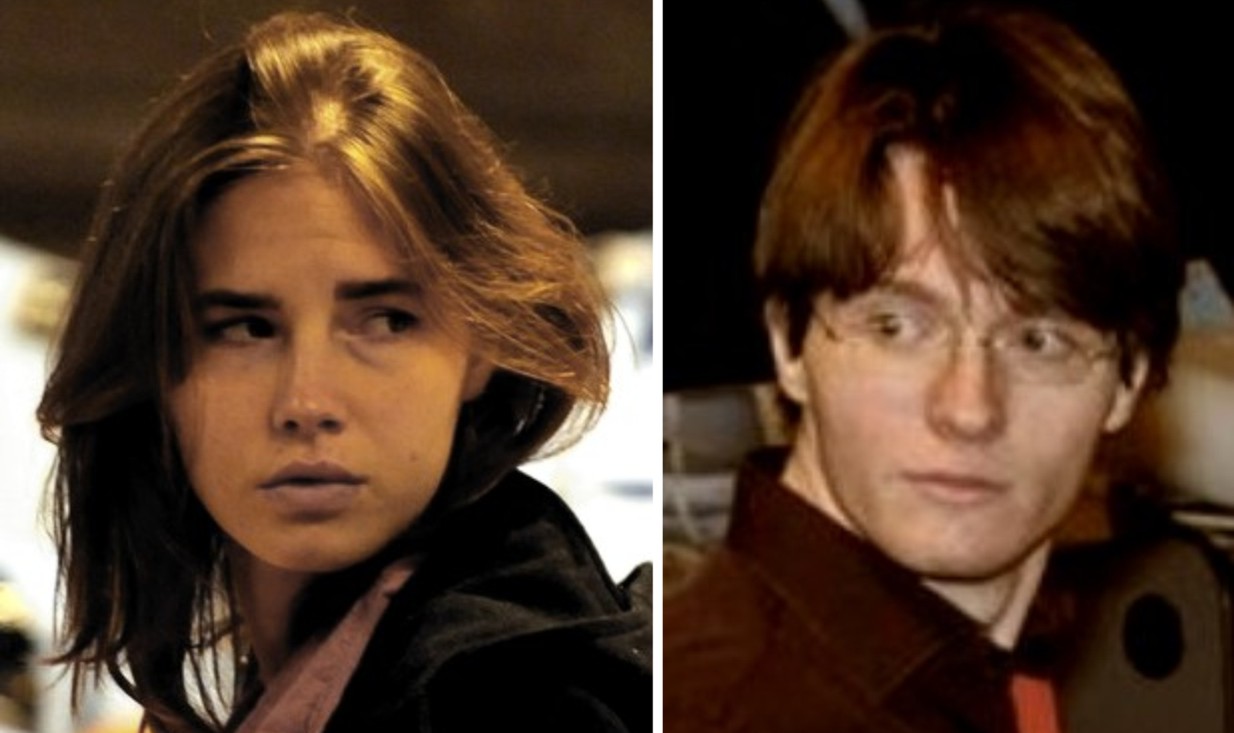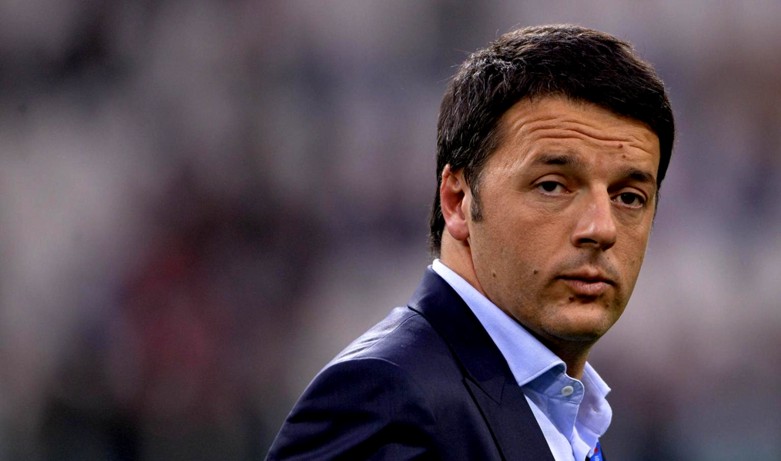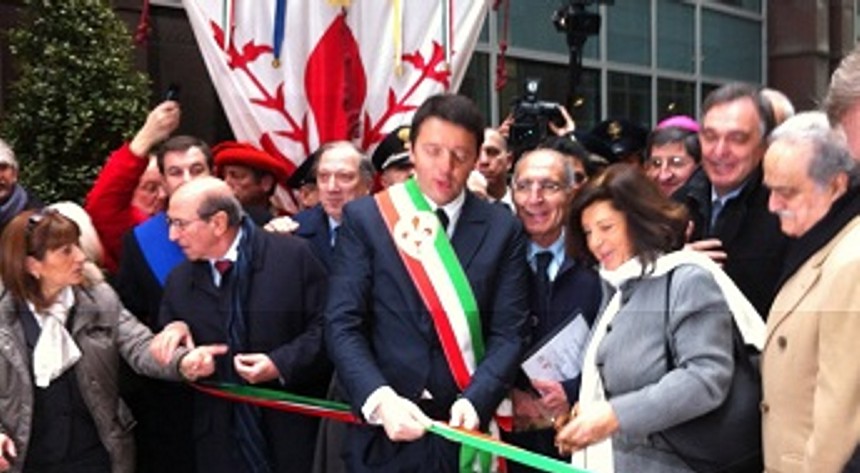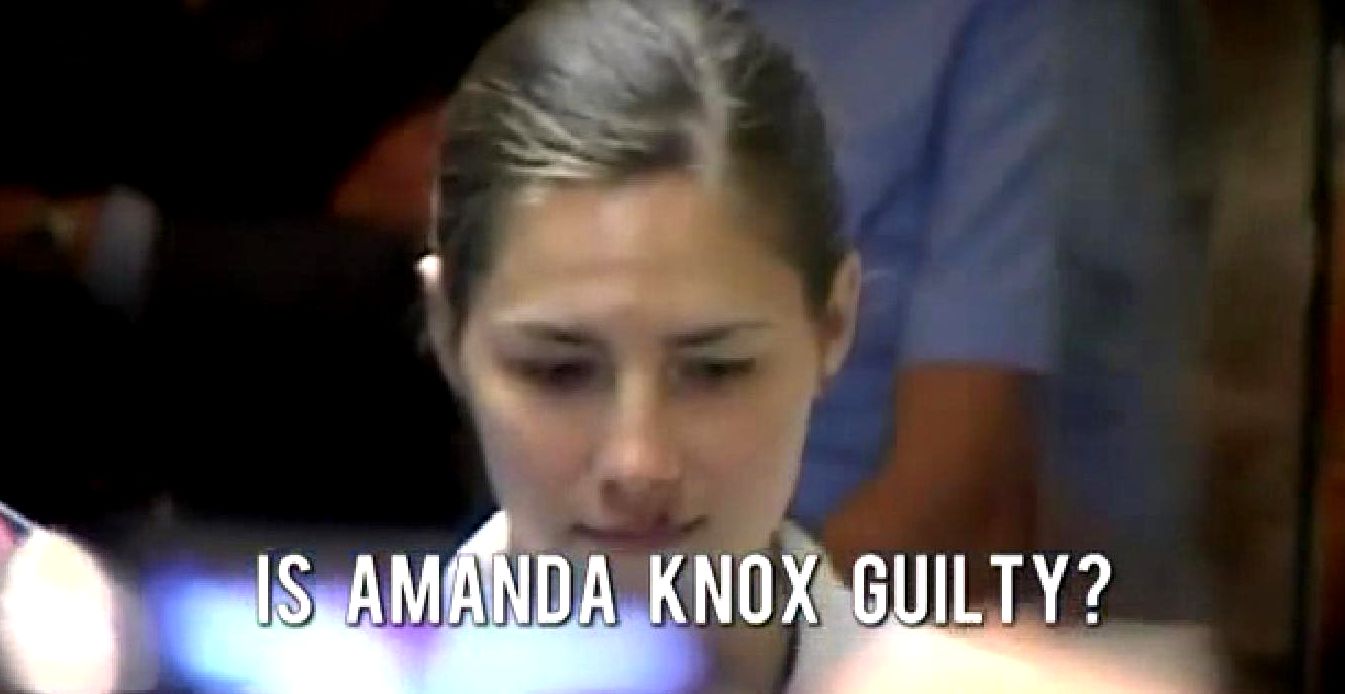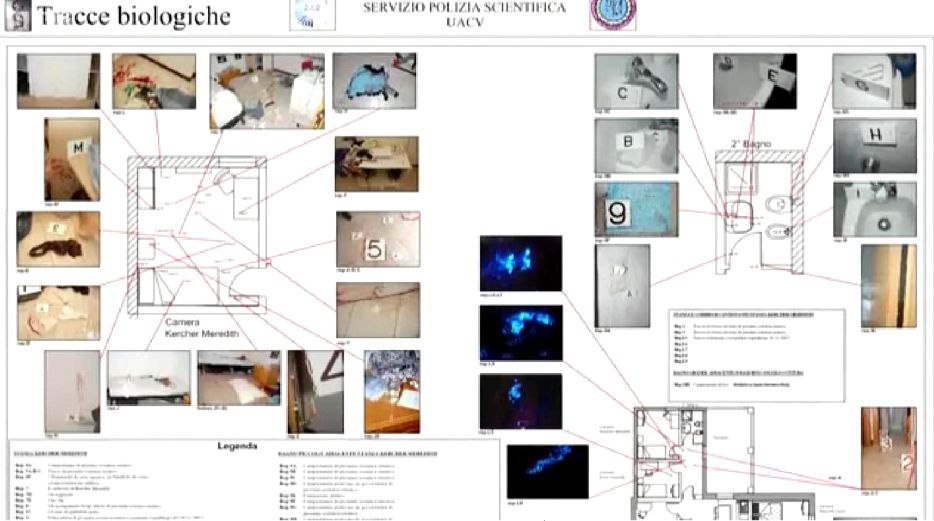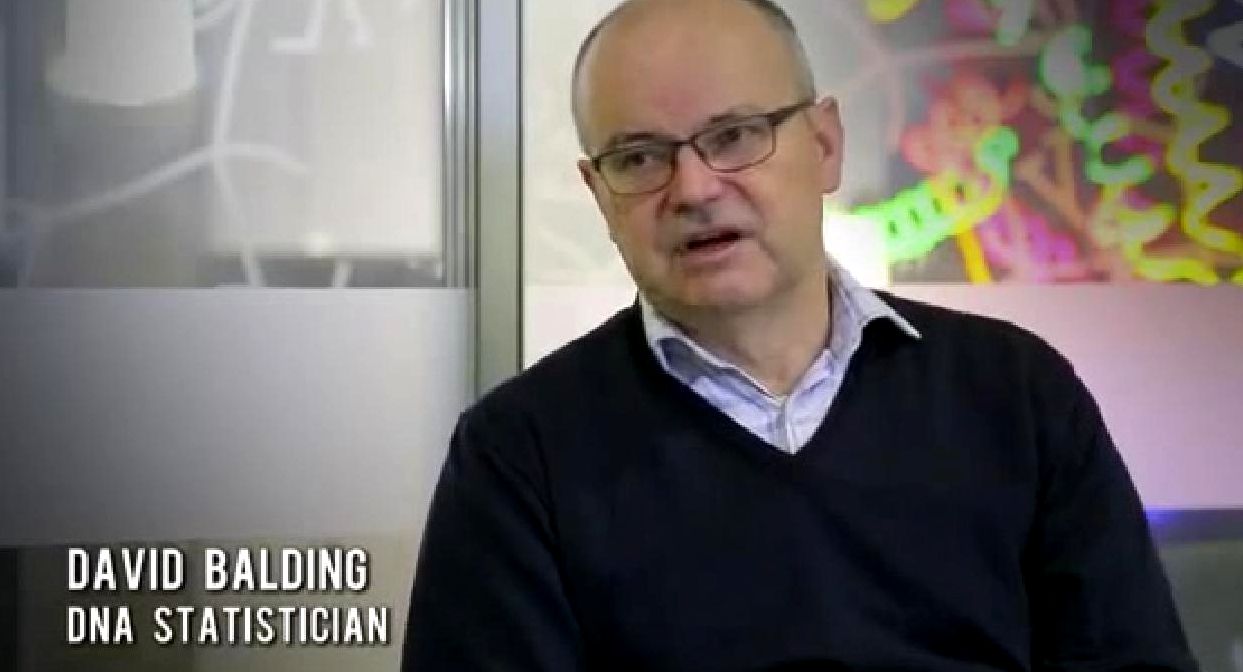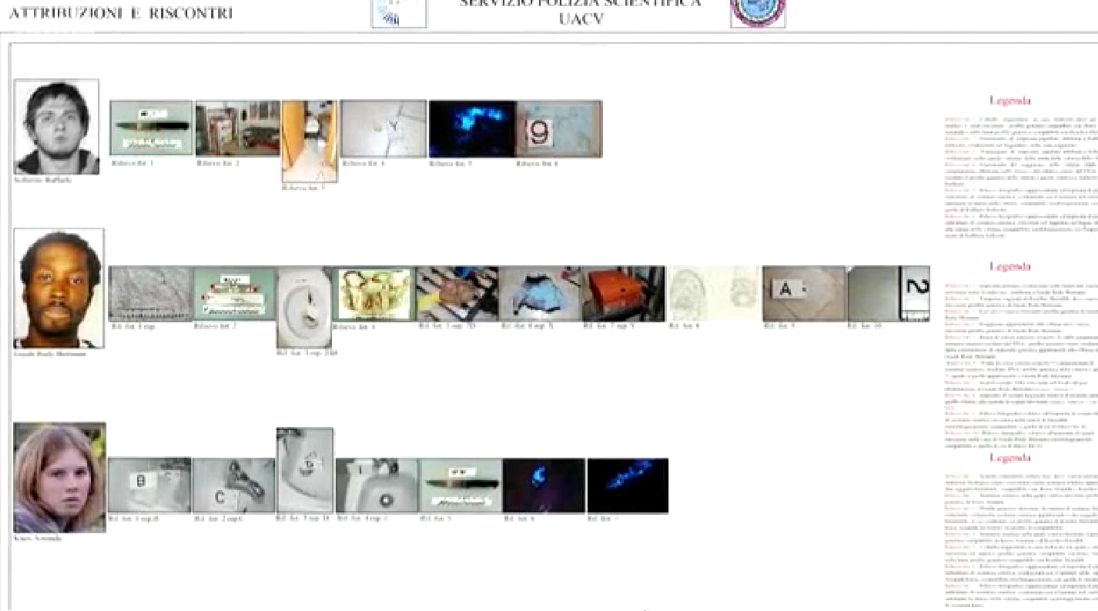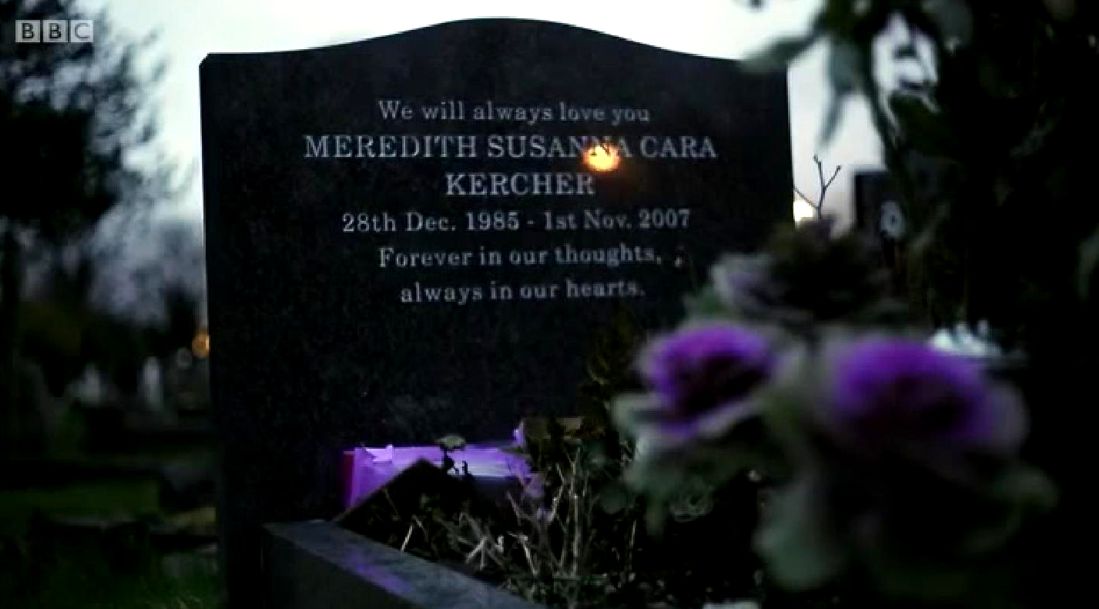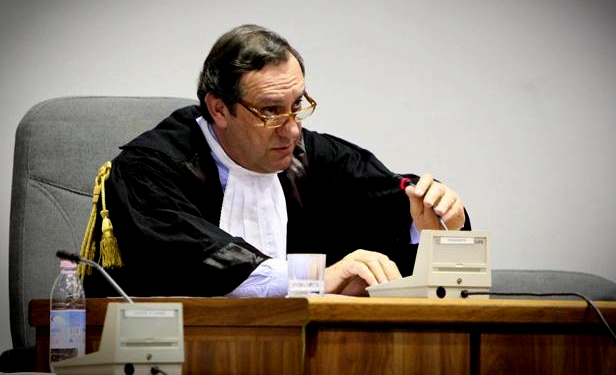
Political & economic headsup: US is demonstrating unsorted systems problems in spades. Do watch your investments. As Washington DC policy gets more & more off-target, big New York investors are betting very heavily that stocks will soon crash. Gross systems mismanagement 2017-20 tanked stocks several times.
Monday, April 07, 2014
Italy Pushes Back On False Claims In Sollecito Book: 20 Examples Of What He Must Defend In Court
Posted by Our Main Posters
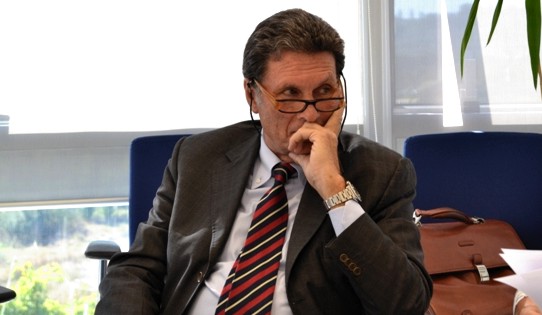
[Florence prosecutor Gianbartolomei will announce RS charges later this month]
Many posters contributed to this analysis and to what is to come. Special thanks to James Raper and Sara, and also to Vivianna, Yummi and Kermit.
1. Sollecito’s blood-money book gets published
Sollecito’s hapless book Honor Bound was released in English on 18 September 2012.
Within ten days all of Italy knew that the book was a crock.
Bruno Vespa, the persistent host of Porta a Porta, Italy’s most popular crime show (for the equivalent of which American TV cries out) forced Sollecito’s father in national prime-time to admit that at the core of the book was a huge lie.
Other claims about the case and the officials were shown to be wrong too.
Smarter people than Sollecito’s help in the US (Andrew Gumbel and Sharlene Martin, later John Q Kelly, and Simon & Schuster) might have put the brakes on until they got the truth straight and a revised version out.
But no, a media blitz was all ready to roar. The blood-money couldn’t wait.
Huge numbers of professional book reviews and Amazon reader reviews swallowed Sollecito’s claims in the book whole. The nastiness toward Italy and its justice system and officials was ratcheted onto a whole new plane.
2. Needless to say, official Italy did take note
For the legal reasons explained in this key post an investigation by the Florence Chief Prosecutor’s Office was mandated to begin.
In that same post it was warned that for the period the investigation would require, it would be taken below the radar, so that the Sollecito defense team would have no way to respond through dishonest PR or legal dirty tricks.
A not-unsurprising result of that stealth move was that in the meantime, in the last year, very full of themselves and feeling no constraint, Sollecito and his team went hog-wild in adding more crazy claims. And still more.
3. Now the investigation is complete
Now Prosecutor Gianbartolomei has issued his announcement of the conclusion of his investigation. The content of the notice is at present confidential except to the defenses.
As Yummi reports, from this point on, the defense has 20 days to say something, such as to request that Sollecito be interrogated or allowed to declare or explain something.
Then the prosecution will file charges against Sollecito and Gumbel, and possibly Sharlene Martin and Simon & Schuster, their careless publishers in New York.
Which precise false claims Prosecutor Gianbartolomei has made the target of his report we do not know. But this is a target-rich environment, that is for sure:
Consider for starters these 20 false claims which, believe it or not, all appear in the first seven pages of the book.
4. Twenty False Sollecito Claims
1. That Italian justice authorities took the easy way out
This is the story of two ordinary people who stumbled upon an extraordinary circumstance, the brutal murder of a British student in Italy. Neither Amanda Knox nor I had anything to do with the crime, but we came perilously close to spending the rest of our lives in prison because the authorities found it easier, and more convenient, to take advantage of our youth and inexperience than to mount a proper investigation. It’s that simple. And that absurd.
No advantage was taken of them. The two stood out very sharply from all the others of similar age, and of similar inexperience (whatever that means). They did and said dozens of things in the early days that set them sharply apart.
They were interrogated quite fairly, the Italian media was not especially hard, Dr Mignini never ever leaked, and they had lawyers and family handy at every turn after they were arrested. They each gave the authorities less than zero help - they tried to lead them off on wild goose chases, for example the false claim AK made against Patrick and dozens of other false claims, and apparently tried to finger yet another north African, Hicham Khiri, in a conversation they clearly knew was being recorded.
A “proper” investigation was indeed done. Simply read through all the posts on the trial here in the first half of 2009, and the prosecutor’s excellent summations, and you will see what a smooth comprehensive job was done. And the Supreme Court concluded that THREE had to have been involved, from the recreation of the attack and all the wounds on Meredith’s body. AK and RS and their lawyers never came within light-years of throwing real suspicion on anyone else.
2. That the preventive custody was very harsh
On November 1, 2007, Amanda and I were carefree students at the beginning of a cross-cultural love affair in a beautiful Umbrian hill town. Within days, we were thrown into solitary confinement in a filthy prison, without access to lawyers or loved ones, accused of acts so heinous and disturbing we may never be able to banish them from our thoughts, or our nightmares.
Raffaele was sent to preventative prison on Tuesday November 6. Capanne Prison was almost brand-new then, and far from crowded. Cells contain TVs and private bathrooms.
All questioning had been stopped early on 6 November until Sollecito could have a lawyer present. He himself wrote to his father in his “prison diary” on November 7: “I may see you tomorrow, at least that is what I was told by Tiziano [Tiziano Tedeschi, his lawyer at the time], who I saw today and who defended me before the judge.”
Mr Tedeschi made no complaint about any delay in the first meeting with his new client. In Italy, a judge must determine within 48 hours whether to hold or release detained suspects. Judge Matteini did so meticulously and refused his release.
3. That the prosecution and Italian media demonized the pair
In the newspapers and on the nightly news, we were turned into monsters, grotesque distortions of our true selves. It did not matter how thin the evidence was, or how quickly it became apparent that the culprit was someone else entirely. Our guilt was presumed, and everything the prosecution did and fed to the media stemmed from that false premise.
In the real world, the prosecution fed nothing at all secretly to the media and publicly very little, none of it self-servingly biased. Italian reporting was sporadic and very mild compared to anything one can see said daily about possible perps in the US and UK newspapers and on US TV. Besides, any coverage, which was in part deliberate in the situation as dozens of students were fleeing Perugia, had no influence on anything, neither on the investigation nor the trial.
The Italian system is set up so media can have less influence than almost any other media on any other justice system in the world. The Micheli and Massei sentencing reports show the judges were not unduly influenced even by the lawyers right in front of them, let alone by mild media reports 1 or 2 years before that.
4. That four years were wasted showing where the prosecution went wrong.
By the time we had dismantled the case and demonstrated its breathtaking absurdity [in the annulled Hellmann appeal] we had spent four of what should have been the best years of our lives behind bars.
“We” meaning the defense lawyers did very little in the annulled Hellmann appeal that they hadn’t flailed uselessly against in the trial. Except of course maybe shopping for an inexperience and pliable judge, and for DNA consultants who they could then spoon-feed. Much of the hard evidence they simply kept well away from in the trial and annulled appeal. Such as the extensive evidence in the corridor and bathroom and Filomena’s room, which were all considered parts of the crime scene.
On the other hand, RS’s claim could well apply to what Dr Galati and Cassation did for the Hellman sentencing report. Dismantled the appeal verdict, and demonstrated its breathtaking absurdity.
5. That Knox was made a target because timid Italy was scared of her.
Amanda and I certainly made our share of mistakes. At the beginning we were too trusting, spoke too frivolously and too soon, and remained oblivious to the danger we were courting even after the judicial noose began to tighten. Amanda behaved in ways that were culturally baffling to many Italians and attracted a torrent of gossip and criticism.
An inaccurate and xenophobic remark originated by the American Nina Burleigh, who was having severe culture shock of her own and surrounded only by other foreigners with similar mindsets. What EXACTLY was so baffling about Knox to the very hip Italians? That Knox was pushy, obnoxious, humorless, rather lazy, rather grubby, and not especially bright or funny or pretty? That she put off Patrick, Meredith, her other flatmates, the boys downstairs, the customers in the bar, and just about everybody else except for the distasteful druggie loner Sollecito?
Read this post by the Italian-American Nicki in Milan. To quote from it “As many of us were expecting, Amanda’s testimony has backfired. She came across not as confident but arrogant, not as sweet but testy, not as true but a fake who has memorized a script, an actress who is playing a part but not well enough to fool the public….. Amanda Knox is not on trial because she is American and therefore too “emancipated”....Italians don’t much like Amanda primarily because they perceive her as a manipulative liar, who is suspected of having committed a heinous crime for which there is a whole stack of evidence.”
6. That Knox and Meredith were really great, great friends.
We were young and naive, unthinking and a little reckless. Of that much we were guilty. But what we did not do””and could not have done, as the evidence clearly showed””was murder Meredith Kercher.
Meredith was Amanda’s friend, a fellow English speaker in the house they shared with two Italian women just outside Perugia’s ancient city walls. She was twenty-one years old, intelligent, and beautiful. She and Amanda knew each other for a little over three weeks, long enough to feel their way into their new surroundings and appreciate each other’s interests and temperaments. I never heard about a single tense moment between them.
Plenty of other people did know of tensions. Meredith’s family and friends all knew Meredith was finding the noisy dirty lazy loud unfocused Knox and her one-night-stands hard to take. Her other flatmates found her hard to take. Her employer Patrick found her hard to take. His customers in the bar found her hard to take. The Lifetime movie got this strident angle pretty straight.
Remember, Meredith enrolled for a full academic load at the main university. Knox in sharp contrast took only one undemanding language course - which anyone could walk into - requiring maybe 10 hours of study a week. They increasingly did less together. In fact after several weeks nobody was lining up to have anything to do with Amanda Knox.
Seemingly unable to reverse herself, she was headed to being among the least popular of students in Perugia. It should be recalled that the callous remarks by Amanda Knox about the death of her so-called friend Meredith included “Shit happens”, “She fucking bled to death”, and “‘I want to get on with the rest of my life”.
7. That an intruder knew about the rent money and so murder ensued.
Meredith, of course, suffered infinitely worse luck than we did: she came home, alone, on an ordinary Thursday night and had her throat slit by an intruder hoping to steal the household rent money.
There is zero evidence that this was the case. Knox herself ended up with a similar amount of cash that she has never been able to explain. There is zero possibility that Guede would know that any money was lying around - or not lying around, as it was concealed in Meredith’s drawer.
And take a look at the many images of the brightly lit house at night. There are several dozen other houses behind it in the dark which any smart burglar would have chosen first. In 2008 two real break-ins occurred at the house - both were in the dark behind the house, which is by far the easiest place to break in.
So much for the spurious lone-wolf theory, which Judge Micheli first ruled out even before trial.
8. That the media got hysterical and portrayed heartless killers.
But the roles could easily have been reversed. If Meredith’s Italian boyfriend had not gone away for the weekend and if Amanda had not started sleeping over at my house, she””not Meredith””might have been the one found in a pool of blood on her bedroom floor. That reality was quickly lost amid the hysteria of the media coverage. But it continued to hover over both of us””Amanda especially””as we sank into the legal quagmire and struggled in vain to overcome the public image of us as heartless killers.
There was zero media hysteria. This silly claim was addressed above. Watch the Porta a Porta YouTubes and dozens of other Italian reports and try to find ONE that is not fair and cautious and mature.
How precisely did the two struggle in vain to overcome their public image? By coming up repeatedly with stories which didnt even tally with others of their own, let alone with one another’s? They never between them made even one helpful statement which actually helped the police. And even their respective parents strongly suspected or knew of their guilt and were all caught incriminatingly on tape.
9. That Rudy Guede did it alone; ignore vast evidence that proves not.
This should not have been a complicated case. The intruder was quickly identified as Rudy Guede, an African immigrant living in Perugia with a history of break-ins and petty crimes. His DNA was found all over Meredith’s room, and footprints made in her blood were found to match his shoes. Everything at the crime scene pointed to a lone assailant, and a single weapon. Guede repeatedly broke into houses by throwing a rock through a window, as happened here, and he had been caught by the authorities in the past with a knife similar to the one that inflicted Meredith’s fatal wounds.
This is laughable. It has in fact been demonstrated in numerous ways that the attack involved multiple assailants and this was accepted by the Supreme Court.
Sollecito’s own lawyers never forcefully argued this. They produced two non-credible witnesses in the appeal trial (Alessi and Aviello) to actually prove that Guede had some other accomplices or that several others did it. Also Amanda Knox if anything diverted attention AWAY from Guede as he did in turn from her. He wasn’t quickly identified precisely because Knox had rather credibly fingered Patrick.
There is no proof Guede was an intruder. The trial court concluded Knox invited him in. Guede had zero proven history of break-ins or petty crimes or drug-dealing, and late in 2008 at his trial Judge Micheli became angry at such claims. Guede had no prior criminal record at all. He had only been back in Perugia for a few weeks, after an extended stay up north. His DNA was not found “all over” Meredith’s room. A major surprise, in fact, was how few traces of him were found.
The recreation of the crime scene and the autopsy both pointed AWAY FROM a lone assailant, not toward. From Meredith’s wounds, it was quite evident that two and perhaps three knives had been used, and not a single weapon. What lone intruder carries or uses two or three knives? And footprints in blood outside the door matched the feet of both RS and AK. This is why the Supreme Court confirmed Guede’s guilt only “in concorso” (with others).
10. That the cops could have caught Guede fast, despite Knox’s frame
Guede did not call the police, as Amanda and I did, or volunteer information, or agree to hours of questioning whenever asked. Rather, he fled to Germany as soon as the investigation began and stayed there until his arrest two and a half weeks later.
Guede’s apprehension and eventual conviction on murder charges should have been the end of the story. But by the time Guede was identified, the police and the public prosecutor’s office had convinced themselves that the murder was, incredibly, the result of a sexual orgy gone wrong, in which Amanda and I had played leading roles. Their speculations ignited a media firestorm, inspiring sensationalist headlines across the world about the evil lurking behind our seemingly innocent faces.
The authorities had no shred of evidence to substantiate this story line, only erroneous suppositions and wild imaginings. We had an alibi for the most likely time of death, and none of the initial forensic evidence tied us to the scene of the crime. Nothing in our backgrounds gave any hint of a propensity for violence or criminality. We were both accomplished, hardworking students known to our friends and families for our gentleness and even tempers.
Four more untrue remarks. All three were convicted of a murder with a sex-crime element and nobody was wrongly “convinced”. Which alibi is Sollecito talking about now? He himself admits in chapter 1 (Love and Death) that they had no “real alibi”. They still have no alibis at all for the second half of the evening, neither of them, when Meredith’s murder indisputably occurred.
Extensive forensic evidence within days tied them both to the scene. Not a single element of it has been discredited in the eyes of the Massei trial and Nencini appeal court. Not even one. Nothing was falsified.
Neither of their backgrounds was squeaky clean. Both had long been into illegal drugs, the loner Sollecito had to be watched by his father and teachers, the increasingly disliked Knox had a history of doing and saying crass off-putting things. Both were lagging behind their brighter peers in their studies and Knox was taking a year off.
11. That the prosecution fed the media a huge number of false claims.
Yet the authorities stuck to their guns. They fed the media a steady diet of sensationalist stories of how Amanda, the promiscuous American she-devil, and I, her sex-and-drug-addled Italian helpmeet, had tried without success to drag Meredith into our depravity and punished her by plunging an outsize kitchen knife into her neck.
Complete fiction. Again, in the real world, as the media reporters all confirm, the prosecution fed nothing at all secretly to the media, and publicly very little, none of it self-servingly biased.
Italian reporting was sporadic and very mild compared to anything one can see daily on possible perps in the US and UK newspapers and on US TV crime shows. There is zero sign this mild coverage mattered to the courts. As the media reporters all confirm, they were fed next to nothing by the police or prosecution on the case,
But whereas Mr Mignini famously never leaks, the defenses are widely claimed to have leaked throughout like sieves. So did Sollecito’s own family - they leaked an evidence video to Telenorba TV, for which they were considered for trial. Even we at TJMK and PMF received several offers of juicy leaks. Here is one example of where the Knox forces leaked - wrongly in fact - and then nastily slimed the prosecution and defenseless prison staff.
12. That the authorities had lots and lots and lots of scenarios.
It might have been funny if the consequences had not been so devastating. Listening to the tortured language of the prosecution””“one can hypothesize that . . . ,” “it is possible that . . . ,” “one can imagine that . . . ,” “this scenario is not incompatible with . . .”””it became clear that the authorities, like the media, were treating our case with the bizarre levity of an after-dinner game of Clue, or an Agatha Christie mystery. Everyone, even the judges in their black robes, had theories they were itching to air.
Have Sollecito and Gumbel ever before been in any other court in Italy or the UK or the US? Every judge and/or jury has to arrive at a scenario on lines not unlike this. That is the whole POINT of having courts - to weight the probabilities in what happened in the crime. The only difference in Italy is that the judges have to think their verdict through for weeks, and then write it all out, and then see it scrutinized by a higher court. This is hardly a requirement to be sneered at.
Gumble and Sollecito should have studied how US and UK juries arrive at their own scenarios. Very few US and UK lawyers think they do a better job. Ask those who watched the OJ Simpson and Casey Anthony trials and bitterly criticised the outcomes. And Italy has a vastly lower rate of false imprisonment than the US does.
13. That Italy is a medieval country with a primitive justice system.
It could have been Colonel Mustard in the drawing room with the revolver; instead it was Amanda and Raffaele in the bedroom with the kitchen knife. How was it conceivable that a democratic country known for its style and beauty and effortless charm””the Italy of the Renaissance and la dolce vita””could allow two young people to be catapulted to international notoriety and convicted of a horrific crime on the basis of nothing at all?
This is not remotely what happened. There was very far from nothing at all. Convictions in the US and UK regularly result based on evidence 1/10 or 1/100 of that here - sometimes from one single evidence point. Any one or several of maybe 100 evidence points here could have convicted them in a US or UK court.
Italy gives defendants every possible break, and the justice system is seriously loaded against victims and their families. Read here and here.
14. That the prosecutors office and media were in a grim embrace.
The answer has something to do with the grim embrace that developed between the prosecutor’s office and the sensationalist media. Like addicts constantly looking for the next fix, each fed the other’s insatiable appetite for titillation and attention. The casual cruelty of “Foxy Knoxy” and her Italian lover became too good a story line to abandon, even when it became apparent it was overheated and unsustainable. Our suffering was the price to be paid for the world’s continuing entertainment.
WHAT grim embrace? WHAT addicts? WHAT fix? WHAT insatiable appetite? WHAT titillation and attention? This is clearly defamatory if it can’t be proven, and we can turn up no evidence that any of it is true. It has to be one of the most foolish lies in the entire book, it is so easy to disprove. These who are being accused of crimes here are career police and prosecutors secure in their jobs, and none have the slightest gain to make from false convictions.
15. That in the justice system speculation and hearsay run rampant
The meandering complexities of the Italian legal system, where speculation and hearsay are allowed to run rampant and time invariably slows to a maddening trickle, did little to help our cause.
Total mischaracterization. First note that by comparison with any country in the world THERE IS NOT MUCH CRIME IN ITALY. There is some minor corruption and still some minor mafia action, but thefts and burglaries and assaults are few and murders even fewer. The main crime if you can call it such is not lining up to pay taxes. Italy’s murder rate is 1/6 that of the United States and its prison incarceration rate is 1/30 that of the United States, so where IS all this crime about which the claimed speculation and hearsay are running rampant?
The legal process could have been fully over by the end of 2009 if (1) there was not the entitlement to two automatic appeals; in UK and US terms there was very little to appeal about; and (2) the Hellmann appeal court had not been fixed to produce a corrupt outcome, as the displaced judge Sergio Matteini Chiari and Cassation and the Council of Magistrates have all made plain.
And compared to American police and prosecutors, their Italian counterparts are famously taciturn under their unusually firm rules. There is media interest, for sure, as there should be when there are crimes, but that also is comparatively restrained. Watch the various Porta a Porta shows on YouTube and you will see how sedate crime discussion tends to be.
The Constitution and judicial code set out to achieve the exact opposite of speculation and hearsay affecting justice, and they do so. Creating this restraint is a primary reason for the judges’ sentencing reports and all the magistrates’ checks of investigations along the way.
This whole series of dishonest claims about the the Italian system in the preface of the book and in a later chapter have clearly not been read through or okayed by even a single Italian lawyer.
16. That in Italy proof beyond a reasonable doubt scarcely exists
For reasons deeply embedded in the country’s history, the concept of proof beyond a reasonable doubt scarcely exists in Italy, and the very notion of undisputed fact is viewed with suspicion, if not outright aversion.
So Gumbel and Sollecito are historians and legal experts now? It would be nice, wouldn’t it, if either were able to explain the remark. This may be an ignorant swipe at the Napoleonic Code on which the law of a lot of continental Europe is based. Ignored is that Italy carried out its own reforms to the Code in 1990 and more subsequently. Much of that reform, it should be pointed out, was procedural or structural rather than substantive law.
There are two things wrong with “..the concept of reasonable doubt scarcely exists in Italy.”
1. It is factually wrong. Italian jurists, the courts, and so on, are well acquainted with the concept as it has been a fundamental aspect of criminal proceedings in Italy as elsewhere for many decades if not centuries.
2. It suggests that Italians are not intelligent enough to understand the concept anyway. That of course is an insult to Italians. Actually they are no less intelligent than the rest of us elsewhere who strive to understand it.
Until the 1990 Reforms the relationship between criminal and civil proceedings in Italy were governed by the principles of unity of jurisdiction and the prevailing status of criminal proceedings. Hence, if the facts were the same then criminal proceedings (to punish the guilty) and civil proceedings (to render liable the guilty for damages) were heard at the same time and still sometimes are, as in the Meredith Kercher case.
What has changed (relevant to the above quote) is that civil cases can be and are more likely to be heard independently from the related criminal cases and, where not, the standard of proof in civil cases (the preponderance of evidence or, as we usually refer to it, the balance of probabilities) is to be applied to the civil case, and the civil case only, rather than be confused with or overriden by the criminal standard of proof (beyond reasonable doubt).
Not an easy task, admittedly, to apply different standards to different tasks, based on the same facts, in the same proceedings, but Italian judges are trained to do this because that is their system. No judge would EVER confuse “beyond reasonable doubt” with “the balance of probabilities” when the issue at stake is depriving an individual of his freedom.
17. That the Italian judiciary has vast, unfettered powers
Few in Italian society wield as much unfettered power as the robed members of the judiciary, whose independence makes them answerable to nobody but themselves.
Radically the opposite of the truth. The paranoid claim reads like it came from ex PM Berlusconi fearful of his own conviction or one of his parliamentary lackeys such as Girlanda.
The checks and balances on judges in the Italian system are enormous, perhaps the toughest checks and balances in the world. Read here and here about them.
All of the best judges in the world are independent and they all follow a demanding career path, not elected (as ex-Judge Heavey was) under zero criteria, or appointed under the political sway of politicians. We wonder if Gumbel and Sollecito have ever heard of the US Supreme Court? Do those judges answer to anybody? No? How unfettered.
18. That the courts are the most reviled institution in Italy.
Many Italians retain a healthy skepticism about the reliability of their procedures and rulings. The courts””tainted by politics, clubbishness, pomposity, and excruciating delays””are the most reviled institution in the country.
As our Sollecito Book pages make clear again and again and again, the Italian system is remarkably NOT tainted by politics, as even the most surperficial watcher of the trials of ex Prime Minister Sylvio Berlusconi would know.
And on the issue of popularity we have previously posted this and this and also this.
Our Italian poster Machiavelli (Yummi), who posted our deep analysis of the appeal to the Supreme Court by Dr Galati, has provided these hard facts:
For comparison, in 2011 the percentage of Italians who declared they trust the justice system “a lot” or “enough” was 53.3%. By comparison, the percentage of Italians who declared they trust the government “a lot” or “enough” were 14.7%, and those who trust the parliament were only 15%.
In 2012, the percentage of Italians who trust the parliament is now only 9.5%, and those who trust the Mario Monti administration are only 21.1%.
Over the eight years from 2004 to 2012 the percentage of Italians who trust the justice system was always bigger than those who trust parliament or government by at least ten points, and in some years we can see a spread of 20, 30, even 39 percentage points achieved by the judiciary over the parliament and government.
However, some cases of corruption (such as our Hellmann-Zanetti case, but also several others indicated by the Rapporto Italia 2012) do hamper trust.
The most trusted institutions in Italy above all are the Carabinieri (74% of Italians trust them) and the Polizia di Stato (71%).
Which means the most trusted institutions are precisely those law enforcement instruments which are deployed to enforce the orders of prosecutors.
19. That prosecutors can spin their cases into any shape they please.
Because the Italian legal system is almost completely blind to precedent and relies on a tangle of impenetrable codes and procedures, prosecutors and judges have almost boundless freedom to spin their cases into any shape they please and create legal justifications on the fly. Often, they are more interested in constructing compelling narratives than in building up the evidence piece by piece, a task considered too prosaic and painstaking to be really interesting.
Whoever wrote this either wasnt an Italian or a lawyer, and either way didnt have much of a clue. The entire Italian system under the post WWII constitution was designed to PREVENT what Sollecito & Gumbel claim it allows here.
There are checks and balances and reviews every step of the way. Magistrates (initially Matteini here) determine what a prosecutor may do in developing and presenting a case. Parties may appeal to the Supreme Court AT ANY TIME as Knox’s lawyers did over her second written confession - which she herself had demanded to make in front of Dr Mignini after he finished warning her of her rights.
Hard for Sollecito & Gumbel to believe, perhaps, but the defense is actually present in the same courtroom. They can raise points of order at any time. So can the defendants themselves, at any time, something maybe unique in the world.
And judges actually have minds of their own. And then there are the unique written sentencing reports, and the two automatic appeals if any parties want to pursue them.
Sollecito & Gumbel should have read the 2012 Galati appeal more closely. The Prosecution’s Appeal To The Supreme Court is available in English here. Precedent has a section to itself - “The non-observance of the principles of law dictated by the Cassation Court in the matter of circumstantial cases (Article 606(b)) in relation to Article 192 paragraph 2 Criminal Procedure Code.”
Well, that’s precedent, via the Court of Cassation no less! How surprising from Gumbel/Sollecito that they should make that claim about ignoring precedent when in fact there it is, going right to the heart of the flawed Hellmann/Zanetti judgement on circumstantial evidence! What else is a Code but in effect a codification, a gathering together, a rationalisation, of best law - and precedent?
There is an absurd irony here, were they aware of it. Perhaps they are. Surely it is Hellmann and Zanetti who have displayed “a boundless freedom” in spinning the case “into any shape they please”, and who have “created legal justifications on the fly”? As for prosecutors doing this, at least Dr Mignini followed the evidence, and American readers may recall the infamous Jim Garrison, the DA hero of Oliver Stone’s movie “JFK” but who in reality, unlike Dr Mignini, was a total and utter crackpot.
And what issue exploded the Porta a Porta TV show in Italy in September 2012? It was Sollecito’s false claim that the prosecution had secretly tried to offer him a deal if he would roll over on Knox. NOBODY including his own father and his own lawyers confirmed him. Evidence against both was overwhelming. Nobody needed such a deal, and Italian prosecutors are highly rules-bound against ever offering such deals.
Sollecito was in effect accusing Dr Mignini of a felony with this much-repeated false claim in his book. (In her book Knox also accused Dr Mignini of a felony.)
20. That the prosecutors and judges in Italy are far too close.
Prosecutors and judges are not independent of each other, as they are in Britain or the United States, but belong to the same professional body of magistrates. So a certain coziness between them is inevitable, especially in smaller jurisdictions like Perugia.
Yes, prosecutors and judges in Italy belong to the same professional body of magistrates. But then so does the defense lawyer Ms Bongiorno. The claim that there is no independence between prosecutors and judges in Italy, in fact a coziness between them, is a bit rich.
Consider, say, the UK. It is true cases are prosecuted by the Crown Prosecution Service, a government body, but in serious cases the CPS will employ barristers from the Inns of Court. There is scarcely a judge in the UK, even up to the highest level, who was not and who is not still a member of one of the Inns of Court from whence barristers, for the prosecution or for the defence, ply their trade.
You can’t walk past an Inn without seeing the names of judges on the roll call on the plaques outside. A judge is still a barrister, just fulfilling a different function, although, of course, now paid by the State. The old school boy tie? Corruption? No, the fulfilling of different roles by members of the same body is called professionalism.
Judges and lawyers all belong to the American Bar Association in the US and attend the same conferences. No sign that this lack of “independence” ever affects trials. This claimed excess of coziness is often ranted about online by the Knoxophile David Anderson who lives near Perugia. Nobody who pays him any attention can get where he derives this from. Maybe he heard it from Hellman?
Perugia prosecutors and magistrates are all known to do a fine job, and the national Olympics & earthquake relief cases involving powerful Rome politicians were assigned for competent handling to where? To Perugia… Defense lawyer Ghirga and Prosecutor Mignini have the reputation of being good friends. And Mignini and Massei would both draw their salaries from the State. But so what? Do not judges and DAs in the the USA do likewise? Are Gumbel and Sollecito impugning the professionalism of the counterparts of Mignini and Massei all over the world? It sure reads like it.
5. About Relevant Forthcoming Postings
Akk of this above analyzes only the first seven pages, out of a book which has several hundred pages. We will post one or two times more during April. Later in the book, there is a lot of venomous sneering addressed at Dr Mignini, although his performance at trial was excellent - and he is now for Perugia’s region (Umbria) the Deputy Prosecutor General.
In Italy Dr Mignini is now and then on national TV along with Michele Giuttari, who pursued the main Monster of Florence theory - not the crackpot theory Preston and Spezi attempted to use to frame someone. At impugning him, Sollecito and Gumbel have failed miserably, and for that are now in the crosshairs of the system.
*******
Many posters contributed to this analysis and to what is to come. Special thanks to James Raper and Sara, and also to Vivianna and Kermit.
[Kermit’s take on Katie Couric, one of several smart TV hosts who suspected a giant con]

Friday, April 04, 2014
The Florence Chief Prosecutor’s Office Announces That Sollecito Will Face More Court Action
Posted by Our Main Posters
Breaking news from Main Poster Yummi
Prosecutor Gianbartolomei has issued a notice about the conclusion of his investigation. The content of the notice is confidential for the defenses.
From this point the defense has 20 days to say something, like to request that the defendant (Sollecito) is interrogated or has anything to declare, or to submit any documents if they want to.
Then, once the 20 days are expired, the prosecution will file charges.
Since the charges will include almost certainly, beyond aggravated defamation, also contempt of the Judicial organs, the prosecution may send a notice to the Ministry of Justice too.
Since they are victims of contempt they may appoint a plaintiff.
The senior Florence prosecutor Dr Giuliano Giambartolomei was assigned to investigate the claims in Sollecito’s “Honor Bound”.
Today he announces that his findings indicate that many claims are spurious and justify new charges being brought against Sollecito. Shadow-writer Andrew Gumbel, who recently published this self-incriminatory rant has also been named.
When the charges are filed several or some others who have been assiduously “helping” Sollecito (mostly for big bucks) such as book-agent Sharlene Martin might find themselves named also
So Sollecito for sure and Knox most probably will be confronting the often-contradictory claims in their books, and saying whether they accept or reject each of them, which should put other book-writers who made false claims on the spot and maybe wind the whole FOA effort down.
We will be making our separate page on Sollecito’s various false claims live again. Main posters have posted a large number of corrections to Sollcito’s claims in the book. We have been putting them in correct page-order.
Miriam has kindly contributed this translation of today’s report in Il Messagero. Dr Giambartolomei only hints to the reporter what will be in his report which will quote all the passages in full for which Sollecito will have to account.
Raffaele Sollecito Insults The PM And A New Trial Starts
As always everything [possible] is presumed and as always, in the case of the murder of Meredith Kercher, everything [possible] can be overturned at every verdict.
Even in the associated trials, such as the one for defamation (against PM Mignini) and contempt (against the police) for which Raffaele Sollecito, found guilty of the murder of Meredith Kercher along with his ex-girlfriend Amanda Knox, is being investigated along with the British journalist-author (now in absentia) Andrew Paul Gumbel.
Defamation, because many parts of the book “Honor Bound”, of which both are authors, contains for the prosecution various ignominious remarks.
More than simple phrases, entire chapters (allegedly) of the book are written in what is technically called “conclusione delle indagini” and requires the matter to be brought to justice, and therefore to trial.
[The book] starts by summarizing the main evidence (that was then proved to be wrong by the facts) against Sollecito.
The two being investigated write: “ the main proof that Mignini had to bring to the preliminary hearing were my Nikes… and he did everything possible to render them more incriminating…”
Then again “the police had only the pictures of my shoes (not those of the print) and in some way they came to the conclusion that my Nikes were the same brand, model and size as the shoeprints on the floor of Meredith’s apartment. There was no doubt about this”
Then the facts demonstrated that the shoe prints where of Rudy Guede, the third person condemned for the murder of the British student, and could not be those of Sollecito, because of the size.
Therefore this touches on the management of the trial on the part of Mignini. Sollecito-Gumbel write: “one of the reasons that our hearings were so distant one from the other was that Mignini was fighting his own separate legal battle for abuse of investigated activity.”
This connection goes to the case of the death of the Perugian Doctor Franceco Narducci, connected to the Monster of Florence case which Mignini had investigated.
Sollectito sustains: (defended in this case by Alfredo Brizioli) “I think our case, among other things, was a big diversion to keep the media’s attention away from the legal battle Mignini was having in Florence, and to give him the victory in a high profile case he so desperately needed to restore his reputation.”
The young Pugliese continues: “”¦..just as he did in the Monster of Florence case, Mignini used every instrument at his disposal against his critics and adversaries. The avalanches of legal action by part of Mignini had an inevitable icy effect , especially on the Italian press and this played a clear role in turning the public opinion against us.”
The charges against Sollecito and Gumbel are those of having sustained that it was Mignini’s idea to seek to obstruct the investigation as is from the beginning, it was a studied act to bend the investigation and turn the trial to his side.”
This is a clear accusation in the eyes of the prosecutor Giuliano Giambartolomei: “His approach (Mignini’s), Sollecito is saying, was particularly vindictive…. This is enough for Sollecito to face charges of defamation.”
Important to note that Dr Giambartolomei does NOT explain here precisely what will be in his report. That will have to quote all the passages in full for which Sollecito may have to account. Then he or whatever prosecutor charges Sollecito will go to another depth.
With our analysis of the book and knowledge of Italian law we can probably pick many or most of the false claims made which impugn officals or the Italian system.
More posts coming. Stay tuned.
Tuesday, April 01, 2014
With Radioactive Knox Campaign Not On Agenda, US & Italian Leaders Give Each Other Big Boosts
Posted by Peter Quennell
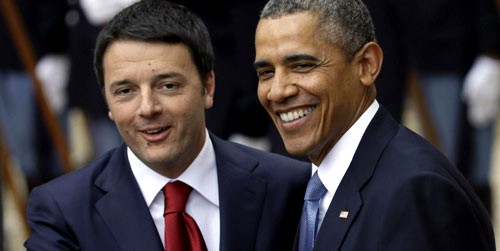
Prime Minister Renzi needs all the support he can get for his economic-recovery program, President Obama the same for the Ukraine.
Here’s a Rome-based blog our main poster Yummi pointed out, which describes in detail chronologically how the productive four days went.
And Mr Obama went out of his way to give Mr Renzi a lot of praise as Reuters described
Renzi, Italy’s youngest ever prime minister, has set a testing agenda of economic and constitutional reforms to help the eurozone’s third-largest economy recover from its longest recession since World War Two.
“I want to say that I’ve just been impressed by the energy and vision that Matteo’s bringing to his position,” Obama said during an hour-long joint news conference in Rome.
“There’s a seriousness and ambition of ideas, and I think the spirit and the energy of the Italian people has the opportunity to be unleashed in a way that will be good for Italy, but it will also be good for Europe,” he said.
“So it’s wonderful to see this new generation of leadership coming to the fore.”
The comments were a welcome boost to Renzi, who took over leadership of Italy’s cross-party ruling coalition after a party coup last month, pledging to push forward more aggressively on reforms than his predecessor Enrico Letta.
Not a single mention by any official or any media outlet of the radioactive Knox campaign. NOT ONE. Ask any justice official in either capital city, and the responses now are ““Knox who?” and “She should go quietly and serve her time”.
She’s old news. Let’s move on.
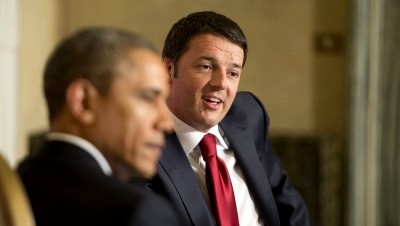
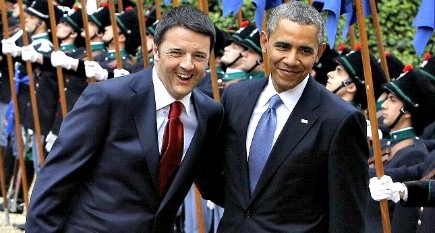
Saturday, March 29, 2014
Silicon Valley Lawyer Richard Dwyer Mulls Knox Fingering Patrick, Also Dewani Killing Wife
Posted by Peter Quennell
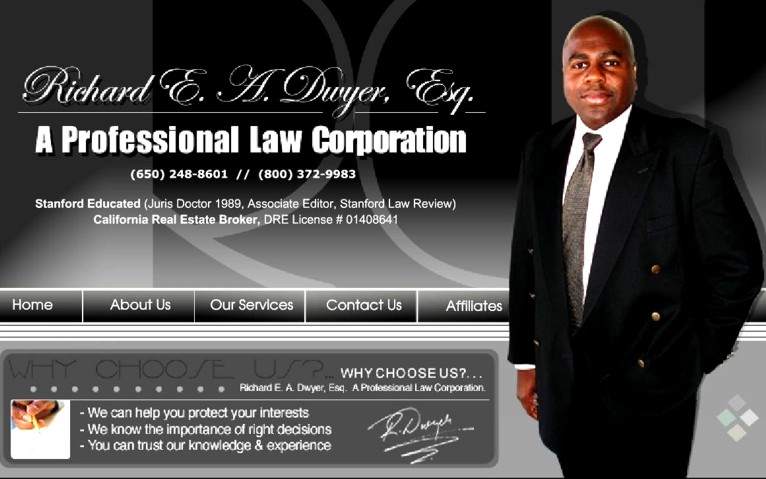
Richard Dwyer is known as a very, very smart Silicon Valley lawyer. He is a Stanford Law School graduate. Using Skype he has posted a lot of astute video analysis online.
Below Mr Dwyer comments with cold precision and a significant depth of detail on the matter of Amanda Knox framing Patrick (15 minutes) which he sees as in itself all an America court could need to find for guilt.
In the second video below he comments on the strong case that South African justice has against Shrien Dewani for killing his wife (50 minutes) to which several posts of ours immediately below refer..
Saturday, March 22, 2014
Italy’s 13th Foreign Oscar Winner Shows A Very Beautiful Side Of Rome
Posted by Peter Quennell
Since 1950 Italian films have won more Foreign Oscars than those from any other country.
And now this. The Great Beauty. Said by some to be a La Dolce Vita for the 21st century and by others to be a Great Gatsby for Italy.
The movie was re-released on 14 March after a limited run late last year and is still playing in many art houses in Europe and the US. The Great Beauty has a 91% positive rating among the critics on Rotten Tomatoes and the reviews sure take off in many different directions.
The Los Angeles Times review started off thus:
As its name promises, “The Great Beauty” is drop-dead gorgeous, a film that is luxuriously, seductively, stunningly cinematic. But more than intoxicating imagery is on director Paolo Sorrentino’s mind, a lot more.
One of Italy’s most impressive contemporary filmmakers, Sorrentino has a superb sense of how to fill a wide screen and, working with his longtime cinematographer Luca Bigazzi, a wizard with camera movement, his visuals display the intoxicating richness of color 35-millimeter film in a way few contemporary ventures can match.
When Sorrentino says in the press notes that “a single shot, if well thought out and balanced, can enthrall and say more than ten pages of dialogue,” he’s as good as his word
Another small shot in the arm for Rome where everybody seems to be headed these days. Well done Rome and well done Italian film industry where movies mainly for adults are still happening.
Friday, March 14, 2014
On Saul Kassin: Our Letter To Dr Douglas Starr Who Wrote An Effusive Profile In The “New Yorker”
Posted by Peter Quennell
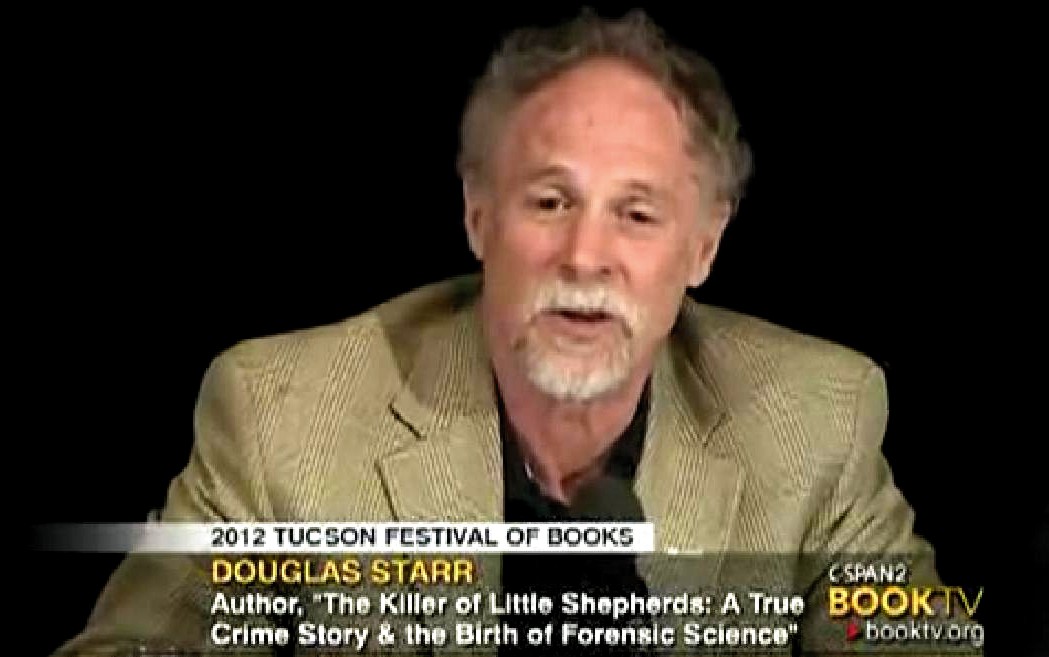
Dr Douglas Starr
Co-director of Science Journalism Program
Co-director, Center for Science & Medical Journalism
Professor of Journalism
College of Communication
Boston University
Dear Dr Starr
We would like to take issue with your article “The Interview: Do police interrogation techniques produce false confessions?” in the Dec 2013 New Yorker.
Specifically the effusive passages on the New York psychologist Saul Kassin. Dr Kassin was a hired gun in the annulled 2011 appeal of the Amanda Knox case in Italy. In our assessment he has widely conflated the defense’s (spurious) position he was paid for with an objective academic analysis.
Our posting community consists of professionals in legal and criminal-science fields, and we have quite detachedly uncovered over 50 false claims in Kassin’s widely-promoted papers and TV and conference appearances. The presumed intent of those was to spark more paid court business and more academic advancement.
Amanda Knox was confirmed guilty for lying about her so-called confession a year ago by the Italian Supreme Court, and her sentence of three years was confirmed. This is the same “confession” Kassin builds huge castles upon, the false accusation which had placed an innocent man in jail for three weeks, during which time Knox never recanted.
So exactly what is left standing of Kassin’s position today is hard to discern. However, instead of exposing him and chastizing him, your New Yorker piece seems to have set out without due caution - no buyer-beware - to make your readers respect and associate with him.
This matter isnt over in Italy, because those many framed by Kassin are unhappy about baseless claims of illegal acts presented at a global John Jay College conference and many other forums and tv shows. Any one of those who feel impugned can trigger a felony investigation for poisoning American opinion in an attempted obstruction of Italian justice. Out of which, Kassin might find himself fighting charges incurring possible prison time.
If credible crime experts here in the United States such as yourself now come down in support of those falsely impugned in Italy, and in rejection of Kassin’s categoric false claims, it might assist to defuse a tense and ugly situation, and might keep Kassin’s legal troubles to a minimum. We dont speak on behalf of the officers framed in Italy but we might have some sway as we accept no payment from anyone and are widely trusted there.
We would like to ask you to read these various posts explaining where Kassin went wrong, particularly the fourth one, and then decide what you might like to do. It would be good if this could include inserting an addendum into the New Yorker explaining that due caution should be observed toward Kassin’s claims.
- 1. Includes a court-accepted widely-confirmed description of the Knox interrogation
2. An Example Of How The Knox Campaign Is Misleading American Experts And Audiences
3. Post Of Jan 2011 Rebutting Kassin’s Substantive Claim Of Forced Confession
4. Correcting Saul Kassin’s Massively Inaccurate Description Of Amanda Knox’s So-Called Confession
5. Passage from Amanda Knox Book Quoting Kassin As Explaining Her “Mental Condition”
If it would help I will need to be soon in Boston and could sit with you. I can also suggest several experts that you might like to consult with.
Kind regards
Peter Quennell
Editor True Justice
Biography
[Everything in this letter applies equally to the ludicrously inaccurate claims of ex FBI “mindhunter” John Douglas in his books and lobbying at the State Department.]
Wednesday, March 12, 2014
Council Of Magistrates In Effect Shrugs At Judge Nencini Answering Loaded Question Of A Reporter
Posted by Peter Quennell
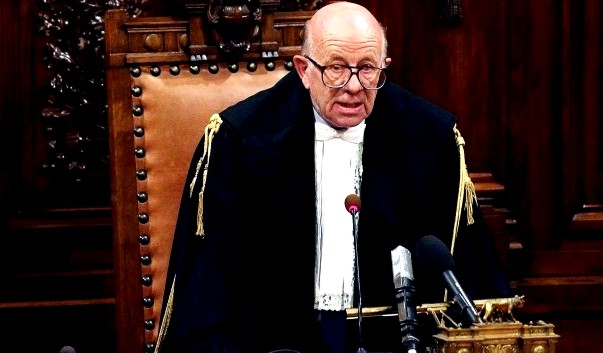
[Cassation judge Antonio Esposito who just faced down a similar complaint to the CSM]
The only ones pushing for the CSM committee hearing today and maybe another one at Cassation were Giulia Bongiorno and a few political friends.
Everybody knows she has once again lost very big and once again is snakily trying to demonize the court rather than gracefully moving on.
The final vote of the full CSM will be announced next week, but it seems a foregone conclusion. The Council will shrug and move on.
Judge Nencini explained himself well for one hour (with his wife, also a judge, present) and probably no magistrate on the Council would have acted so differently, given that the michievous reporter had been asking if the killing of Meredith happened simply because the three had nothing better to do.
Maybe some of the magistrates were thinking “So Bongiorno didnt put Sollecito on the stand? Hmmm, she KNOWS of his guilt only too well”. There is no mood among them to to see the defiant Sollecito who has slimed the system and slimed a much admired judge use a loophole to get himself off.
Jools explained the context of today’s hearing several weeks ago and translated one of the media reports for us today.
Knox, Sollecito judge unlikely to be disciplined by CSM
Inquiry over post-conviction press statements
Rome, March 11 - The Italian judiciary’s self-governing body, the CSM, is likely to drop an inquiry into a Florence judge who broke Italian legal convention by giving press interviews after convicting Amanda Knox and her ex-boyfriend Raffaele Sollecito for the 2007 murder of British student Meredith Kercher in February, judicial sources said Tuesday.
In Italy, judges usually only talk about their verdicts via written explanations published at least a month after they are handed down. But Alessandro Nencini, the head of the panel that sentenced Sollecito to 25 years and American citizen Knox to 28 and a half years at the repeat of the appeals-level trial, gave three interviews to different newspapers that were published February 1.
As a result, Nencini was accused of being biased. One of the most controversial aspects is that in one of the interviews, Nencini seemed to suggest that the fact Sollecito had not allowed himself to be cross-examined had damaged his chances of getting off.
The judge told a CSM commission Wednesday that he did not give interviews, but rather spoke in passing to reporters at the courthouse. He also denied saying the murder was the result of ‘‘kid’s play’’ gone wrong, or expressing an opinion on Sollecito’s defense strategy.
The hearing transcript will be available within a week, when the CSM commission will make its opinion official. The consensus seems to be that Nencini’s statements to the press may have been ill-timed, but not enough to justify a transfer, judicial sources said. Nencini is still not out of the woods, pending the result of justice ministry and Cassation Court inquiries that could lead to disciplinary action against him.
Monday, March 03, 2014
As Knox & Sollecito Try To Separate Themselves, Each Is Digging The Other In Deeper
Posted by willsavive
1. Sollecito Blabs Yet Again
One of an increasingly long list of “gotchas” for the prosecution, flowing from their tendencies to talk way, way too much.
In a recent exclusive interview on an Italian TV news broadcast, Sollecito said he has several “unanswered questions” for his former girlfriend, Amanda Knox.
“You all know that the focus was only through Amanda to her behavior, to her peculiar behaviour, but whatever it is, I’m not guilty for it. “Why do they convict me? Why do put me on the corner and say that I’m guilty just because in their minds I have to be guilty because I was her boyfriend. It doesn’t make any sense to me.”
This adds yet another waiver to the many different explanations Sollecito provided over the years about the same details.
In their “official” story, in the part that remained consistent, Knox and Sollecito both claimed that Knox left his flat the morning after Kercher’s murder and returned home, where she noticed the door left wide open and witnessed blood spots in the bathroom.
Knox claimed that she found it odd and just assumed that one of her roommates was menstruating and left blood behind. She proceeded to take a shower and returned to Sollecito’s flat and ate breakfast.
2. Telling Narrative Change
“Certainly I asked her questions,” Sollecito explained in his latest interview. “Why did she take a shower? Why did she spend so much time there?” When asked what responses he had for these question Sollecito replied, “I don’t have answers.”
In the interview, Sollecito said Knox left his apartment to take a shower, then returned hours later looking “very agitated.”
Yet, in an interview with Kate Mansey on 4 November 2007 just two days after the murder, and two days prior to arrest, Sollecito said:
But when she went into the bathroom she saw spots of blood all over the bath and sink. That’s when she started getting really afraid and ran back to my place because she didn’t want to go into the house alone.
3. RS Differs Sharply From Knox
This is a far cry from what Knox said in her email also dated 4 November 2007 to friends and family, Knox wrote:
I returned to raffael’s place. after we had used the mop to clean up the kitchen i told raffael about what i had seen in the house over breakfast. the strange blood in the bathroom, the door wide open, the shit left in the toilet. he suggested i call one of my roommates, so I called filomena.” (6th paragraph).
The discrepancies between Knox’s version and Sollecito’s version is strikingly different.
- Raffele claims Knox was visibly distraught when she returned and that this was the focus of discussion (i.e. being the first thing they discussed).
- Knox claims that she did not even bring up the bizarre circumstances back at her apartment until “after” they finished mopping the kitchen floor.
4. My Analysis Of The Above
In his latest statement, Sollecito is clearly trying to distance himself from Knox, believing that there is far more evidence against her than against him. But:
- Sollecito forgets to mention the bloody barefoot prints at Knox’s apartment, found to be in Kercher’s blood attributed to him.
- Also the knife found in his apartment that scientists say was the murder weapon.
- Also his DNA found on Meredith Kercher’s bra that was found in her room, even though Sollecito claims that he was never ever in that room.
- Also his own strange behavior, which includes providing a false alibi (saying he and Knox were at a party with a friend on the night of the murder).
Also several conflicting other versions.
But what’s there to question if you [Raffaele] were with Knox the whole day and night of Meredith Kercher’s murder?
It appears as though Sollecito is alluding to the notion that he knows something far more than he is saying; yet, he is being very careful with his words””only providing us with a hint of this.
His latest statement is a clear attempt to distance himself from Knox.
5. Sollecito Freaks Out On Twitter
Sollecito appeared on Twitter recently, for what he claimed was to answer questions and clear his name.
He was very outspoken of his innocence and had no problem in his witty, sarcastic responses to those who questioned his innocence.
However, when I asked him about the Mansey interview he denied claiming that he was with Knox at a friend’s party on the night of the murder [huh?!].
Sollecito disappeared for a couple of days, came back to Twitter writing only in Italian, and ceased responding to any more questions.
Is it possible that Sollecito will turn on Knox altogether at some point when the pressure mounts over the next year? Guess we’ll have to wait and see”¦
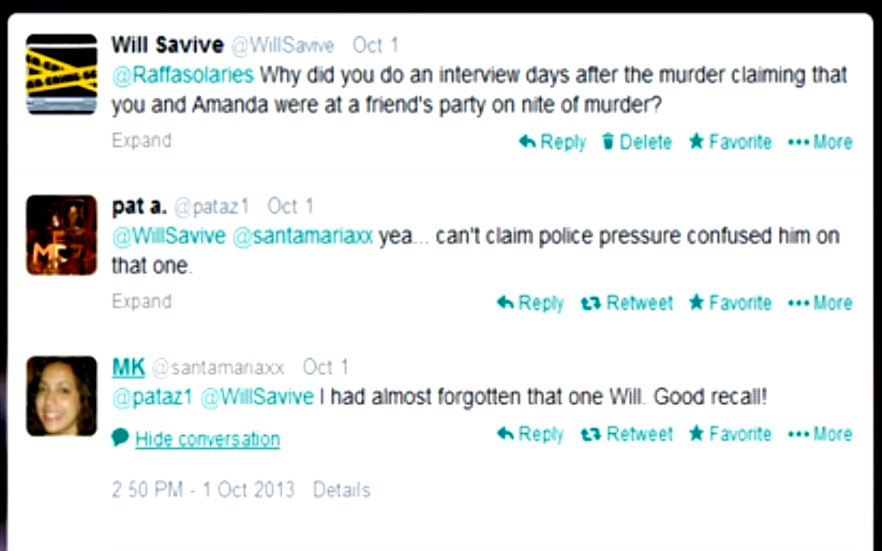
Cross-posted from Savive’s Corner
Friday, February 28, 2014
What We Might Read Into Sollecito Lawyer Giulia Bongiornos Final Arguments To The Appeal Judges
Posted by Machiavelli
Under the table & over the top
The picture of a serene-looking Giulia Bongiorno waving a couple of knives in court on 9 January may be visual inspiration to this reflection about what we can understand from the structure and content of her closing arguments.
A very peculiar feature of her arguments was the desperate opening, suggesting to put the investigation ““ and the whole justice proceedings ““ on trial.
The introductive topic of her speech is a quote from a book by Alessandro Satta, a narrative description of the riotous irruption of the mob inside the Revolutionary Tribunal hearing room on Sep. 2. 1792, the defendants are the some of the King’s Swiss guards.
The passage by Satta describes the “horrendous” vision of a hord of sanculots slowly gathering outside the court, Bongiorno compares that to the angry mob in Perugia after the first appeal verdict.
But if you read the same text by Satta a little further, a few lines beyond the snippet Bongiorno was reading, the narration goes on describing how sanculots manage to enter the courtroom, in a force of hundreds ready to lynch the defendants, but they are suddenly halted by an authoritative order of the Judge, and they unexpectedly obey.
Just after that, Satta drops in an explanatory quote from the book Le Tribunal révolutionnaire (by historian Lenotre) saying: “the people understood that these highly educated individuals in black robes would have gone on with the action started by the hords, and they would accomplish it more perfectly”.
It seems like Bongiorno opened her speech with an implicit depiction of the judges and magistrates of Perugia as kind of Jacobin extremists whose task is to “legitimize” the vindictive fury of a pitchforks mob.
The quote she read did not include Satta’s conclusive lines, so that the consequent thought about the judges’ role remained unexpressed and in the background.
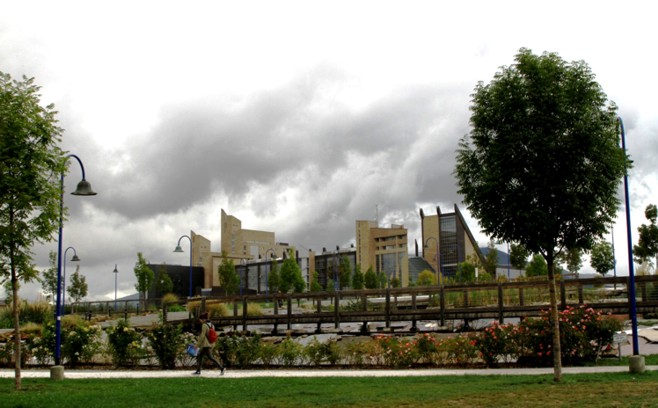
(Photo by Machiavelli_Aki)
A side note about Bongiorno’s arguments: in fact I had the feeling that allusion to implicit subtexts was something that belonged to her speech as a method or a style, it marked the whole of her arguments. You may recall Wittgenstein’s dictum “This work consists of two part, what is written in it, and what is not written in it. The latter is the most important part.”
Such a motto might be apt to address the major feature of Bongiorno’s defensive argument, insofar as she conveyed that something that “couldn’t be talked about openly” was there and that was probably a main argument.
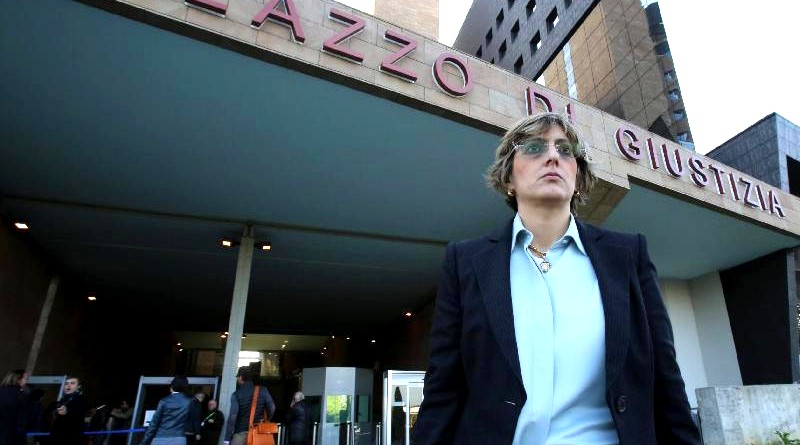
(photo by Ansa)
At first, as I said, she went through a brief emotional recollection of her moments while in Perugia surrounded by a raging mob, and then she unfolded the rest of her introductive section.
The purpose of this bit of revolutionary narrative first juxtaposing the Perugian citizens to Sanculots and the judges to Jacobins, and then, immediately following, a series of accessory arguments all encompassed by an introductive function, all this was clearly intended to set a framework thesis meant to work as a basis for the structure of the whole defensive arguments.
It is in fact a peculiar structure, apparently entirely resting upon one, single elaborate premise.
The thesis she places at the foundation of the entire defensive argumentation is the following: the trial as a whole, as much as its outcome, had been somehow determined and “tainted” from the beginning by events which occurred within a very short framework of time, in the very early days of the investigation, the weeks around the time of the suspects’ arrests.
Bongiorno suggested that only this “short period” ““ the early days of November 2007 - is what matters and the only topic worth of a defence analysis; since this was the time frame within which - according to Bongiorno - everything was decided, this was the time when some “errors” in the investigation occurred, before the point when a veil of prejudice and hatred fell upon people’s hearts and minds like kind of black curtain, preventing from that moment on any fair or rational judgement.
Aggressive Digressions
After the quoting of Satta’s speech, she develops her introduction for a while, branching out into some political-sociological speculations (such as that authorities chose the crime scenario that was most reassuring for the population) as well as some political-anthropological consideration (like the theory that free spirited women are seen as suspicious as a consequence of women empowerment movements).
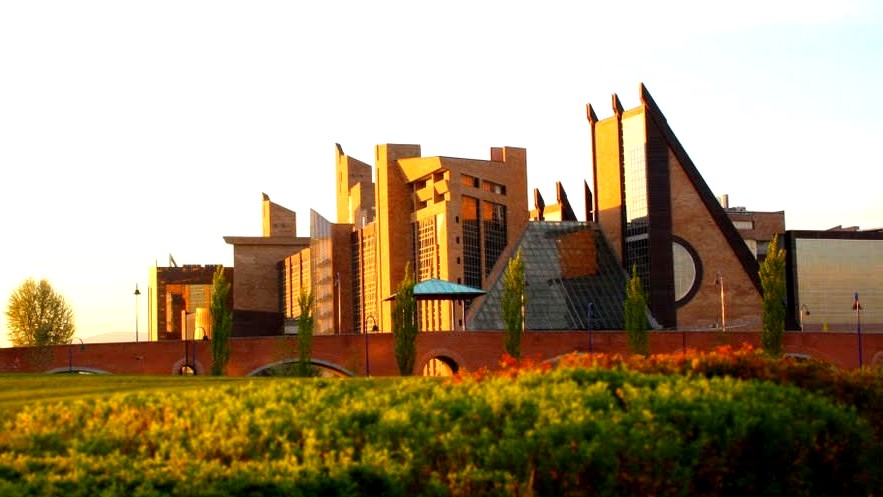
(Palace of Justice of Florence ““ photo by FrederickStudio)
A speech opening as did Bongiorno’s, that is, relying on a set of over-the-top considerations, and apparently so much depending upon one extreme premise, unavoidably conveys a perception of weakness, which is at risk to be transferred to the rest of the argumentation.
Thus, it would be a logical question to ask ourselves: why did Bongiorno chose such a setting and introduction, with several risky, over-shooting arguments?
A perception that the argument was unconvincing was palpable among the public as she was unfolding her theories about Perugian police opting for “political” scenarios and about sexy and free women seen as suspicious because of the women’s political movement.
Scepticism emerged even more openly when she described a scene with Amanda Knox releasing her false accusations while speaking under the hypnotic influence of interpreter Anna Donnino - whom she called “psychic” ““ which triggered some stifled laughs among the public.
Then her long introduction dealt with the unfolding of a rhetorical structure set around the concept of “half”.
I use the word ” rhetoric” in a most technical, non-derogatory sense, to mean the setting of a clear order and concepts designed to be easily remembered, anchored to multiple implicit suggestions, so as to remain impressed in the mind of listeners what is distinctive of the style of Giulia Bongiorno.
Introducing to “˜Halves’
In the previous trial instances she didn’t miss the opportunity to borrow characters such as Jessica Rabbit, Amelie and the Venus in a Fur. I thought she would mention at least a few characters of Disney or the Harry Potter saga this time too, and I was not disappointed as she met expectations on this matter (she did mention Harry Potter, the Eskimo kiss “˜Unca-Nunca’, the Bunga Bunga, the Aladdin Lamp and 9½ Weeks).
She entered the topical part of the introductive section saying “˜basta’ to always focusing on Amanda’s personality alone, while considering Raffaele just Knox’s other “half”, he is not half a character, he should not be seen as reflexion of Knox.
The curse of being “half” chases him also, meaning there are only “half pieces of evidence” against him. And this is the rhetoric structure envigorating the arguments after the introduction, the concept of “half” .
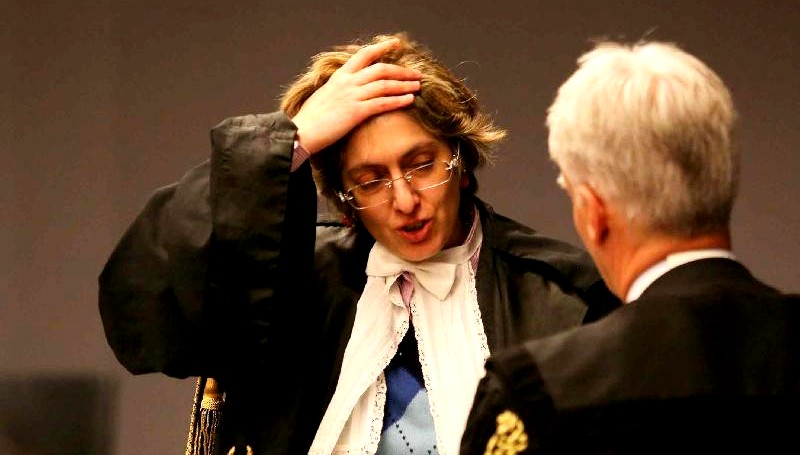
Only half pieces of evidence, almost a half admission, or the clear suggestion that there is maybe one “other half” of something (of culprits?) somewhere else, something not to be said, something that is not here.
The concept of “half” recurs and somehow pervades her defence, we should say something more about later on because she picked it up also in the subsequent hours of speech.
Some videos from the Florence trial available may still be available at the Sky site.
Primordial Fossils
Only after recollecting all these things in the “˜aggressive digressions’ over the introductive part, she goes on with a ponderous section which is the main part of her argumentation.
It’s a topic directly stemming from the introductive themes and premises, in the sense that this main part focuses on and blows up events of the first four days of investigation. It zeroes on few small details of the investigation history, the previous introductive part functionally working to justify the choice and to limit the argumentation to these topics.
Something the listener would notice from this first and main part of the arguments, as everyone well understands, is that these arguments are arranged in a peculiar type of architecture. A choice that makes crystal clear the actual state of the defence’s options.
The defence strategy is to focus attention on the supposed flaws in evidence collection at the beginning of the investigation, and not on the evidence set itself.
Bongiorno’s arguments do not map out the evidence set array. They do not devolve an effort of analysis in proportion to the actual weight of the of pieces of evidence.
The bulk of her speech in fact can be summarized as a criticism of some historical happenings ““ what she sees as such ““ which allegedly occurred within a very small time frame. She devoted hours to attacking the beginning of the investigation, early errors such as that the shoe print that had been wrongly attributed to Sollecito on a first assessment.
It appears this attack against the early procedures of the investigation was really considered to be the most effective weapon the defence had left.
The “˜topics’ Bongiorno addressed in this attack as “˜main points’ of evidence against Sollecito, are only three: the wrongly attribute shoeprint, Sollecito’s side-tracking the investigation, and “˜the knife’ (a topic which gets picked up again later, with a long discussion focused on the blade length).
In the same “˜knife’ topic she included DNA discussion, in a connected digression she dealt with the bra claps, called all the scientific evidence collection “˜the mother of mistakes’ and offered again the known criticism of Stefanoni’s alleged “suspect-centred”.
Later in her speech, she dealt with the other evidence topics, parroted the “˜principles’ expressed in the Conti & Vecchiotti report, offered the known arguments about the bathmat print, etc.
But the bulk of her defence hinged around those “˜mistakes’ in the early investigation phase, this was the actual core of her argumentation, while the other pieces of evidence were dealt with summarily, I had the impression they were almost treated as accessories.
It was clear above all that the defence was not battling the structure of the evidence actually existing today, they were battling a minuscule part of it, or better they were battling something else, something which is not directly the evidence, but rather some historical foundations of the accusation building.
Basically what Bongiorno conveyed is, the fighting terrain was the “˜investigators’ errors’, their “˜excesses’. That is, they were not actively contending Raffaele’s innocence any more.
The implicit content was rather obvious to the listener: a direct claim of Sollecito’s innocence had been already abandoned, that territory was left beyond the lines and the defensive front had been drawn back.
The topic now was not innocence, but rather how the accusation had been unfair and excessive.
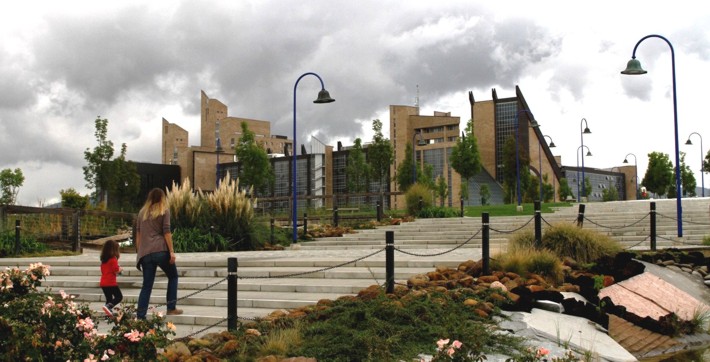
At her opening, the quote of Satta was a device to draw attention to the events at the “origin”, so as to prepare listeners for the fact that defence arguments will be focused on what happened during the moments before the “black curtain” came down.
Hence the a long introduction starting from an image of the fury of a mob of sanculots, a narrative on this theme: people were willing to convict the defendants immediately and judges were legitimizing people’s violence.
She oriented the discussion towards the topic of early prejudice and excesses, so to justify the fact that she will talk about the early phases rather than the evidence set, and then she introduced the leit-motiv of the “half”.
This means, rather than disputing the pieces of evidence, Bongiorno wanted to set a “trial of the investigation”, she zeroed on just a few details actually not having much relevance in the actual evidence set.
She talked at length about elements that are kind of fossils ““ like when she went on discussing about the number of circles in the sole of Guede’s shoeprint ““ putting the alleged “errors” in the course of the investigation on trial, and her speech at times sounded as if it was a lecture about dinosaurs, recalling curious things now extinct.
The explicit function of her introduction was to justify her setting aside the evidence set, downplaying it by framing it into a historical moment, maintaining that it was collected and interpreted when investigators were already beyond the “black curtain” of bias, therefore tainted by prejudice, while judges were like sycophants before an angry mob.
The purpose behind the Black Curtain
The implicit, most important function of the introduction was accomplished via the concept of “half” and all the subliminal suggestions attached.
We should ask ourselves: is it reasonable to believe Bongiorno was so naïve to expect that the court may accept a theory about a dismissal of evidence in limine?
The answer is no. Bongiorno knew perfectly well that her preliminary criticism of the investigation would not lead to a dismissal of the evidence.
Bongiorno also knew that the series of preliminary arguments she would offer would be considered ineffective by judges. Such as that the knife DNA should be seen as unreliable preliminarily, that Stefanoni’s work lacked “transparency”, that Vecchiotti and Conti’s “method” should be taken at face value (Bongiorno knows C&V’s intellectual honesty was called manifestly questionable by the Supreme Court ), that this and that allele in the bra clasp DNA should not be considered because, etc.
She also knows that this court will not allow pieces of evidence to be considered separately from each other in a parcelled out way, and that imperfection of single pieces themselves do not work as a logical argument. Even less could she dismiss the evidence based on political and anthropological theories.
From the fact that she was setting afoot on a trial of the investigation instead of battling the evidence, the rational listener infers that she is well aware of the weakness of her position, since it implies that the evidence set as the battleground would be indefensible. She needs to search for another terrain of attack, a different structure, as the only possible move.
But there is also another implication. She does need to engage and draw attention to areas where she could “win” something, but this also means that her intent was to “soften” the accusation, to work it out at the flanks rather than face it frontally; to reduce the size of some fundamentals, the “excess” of the accusation.
In other words, to shorten the sentence. And if possible, to separate Sollecito’s position from that of Amanda Knox, albeit within the boundaries of her client’s plea.
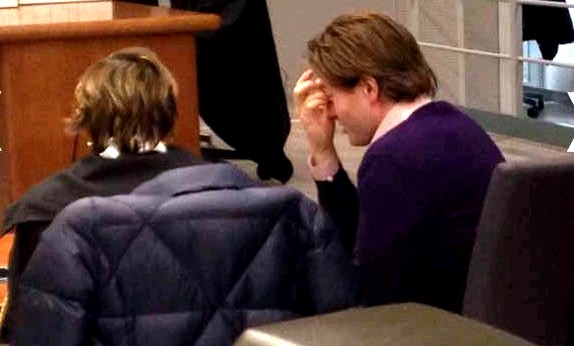
Her strategy of attack had a reason, that was to try to soften the accusatory attitude against Sollecito. Besides being risky (may sound extremely unconvincing) the strategy was also loaded with implicit meanings.
What was most stunning to me ““ as it was a recurrent topic through her whole speech ““ was the concept of “half”. She picked up this introductive theme several times, such as while speaking about the medical findings explaining that only “half” the length of the blade would be used, if a knife so large as Sollecito’s kitchen knife was used, saying that, in this event, this would mean the perpetrator did not intend to kill and killing was the effect of “mistake”, an involuntary movement.
The importance of the length of the big blade and its “half” was emphasized by a waving of knifes, in a quite impressive theatrical performance: “Either the big wound was made by a smaller knife” that was held by “someone else” or the knife was “plunged only by half” showing there was no intent to kill.
All this is to be coupled with the fact that, as said above, she devoted a main portion of her 6-hour speech to discussing things that are fossils, elements not existing any more.
She dealt later with other pieces of evidence too, though in a way that seemed somehow marginal, and she did not deal with some of them at all - the inconsistencies in Knox’s account, for example, were left completely out.
She was not that kind with Knox’s written memorials either, calling them “farneticanti” (waffling, raving).
I noted her complaining about Raffaele being “halved”, as his character is portrayed as depending on Amanda’s and thus seen as equally guilty insofar he was Amanda’s half ““ and this effect is somehow transferred to pieces of evidence.
Bongiorno’s rhetoric emphasizes that Sollecito was accused on “half” pieces of evidence (you perceive that the metaphorical repeating of “half” implies that evidence actually exists, “by half”, and at the same time this complaint about being seen as “half” of something is a subliminal suggestion that the defendants should be considered separately, and their charges as well, thus maybe their responsibilities if considered separately may be different; and when it comes to discussing how the murderer used only half of the blade, the subliminal suggestion is bring down the charge by half, involuntary event/manslaughter versus voluntary murder).
The Mark of Infamy
Giulia Bongiorno picked on the investigators and acted as if she was putting the investigation on trial not because she thought that this would lkead to the defendants being found innocent, but exactly for the opposite reason, because she expected them to be found guilty.
Insults against Prosecutor General Crini, against witnesses and and gratuitous accusations are a risky path but they are also an overt attempt to “soften” the investigation scenario, rather than fight it frontally.
She had no hope to make her client look innocent, her only hope was to soften the strength of the accusation, to make him look less guilty, not so bad as the investigators saw him.
She pursued this in two ways, by suggesting that he should not be seen as the “half” of another perp but rather his responsibility should be considered separately, only that evidence which proves directly against him (Bongiorno repeatedly pointed out that Knox did not utter his name in her interrogation and statement), his actual responsibility might be much lesser than the charge for which he is accused.
The other arm of the defence’s pincer move, the second way to try diminish the accusation, was to portray the investigators in bad light. The “˜excess’ of accusation was to lay blame on investigators for their bias and errors.
Bongiorno’s attack against the investigation might be intended to achieve a psychological effect due to comparative process.
If you consider how the police are responsible for “˜excesses’ and disputable behaviours, you may think the investigators have been prone to gross mistakes that lead to exaggerating Sollecito’s implication, thus the accusation should be not be taken at face value and should be corrected. Maybe the correct assessment of evidence proves he not as much implicated as they had thought.
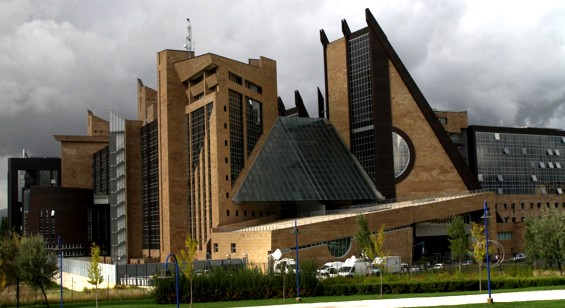
This seemed to be Sollecito’s own defence strategy, albeit implicit, since Bongiorno must restrain her action within the boundaries of her client’s plea.
In order to follow her strategy, however, Giulia Bongiorno decided to take a few steps which must be pointed out as particularly reprehensible and infamous.
I was surprised and stunned by those action because they qualify the character of Giulia Bongiorno as far worse than I thought, I really did not expect her to stoop so low.
The infamous part of Bongiorno’s speech is her gratuitous name calling and defamatory attack against Anna Donnino, her attempt to smear her professional reputation and the rude insult in calling her a “˜psychic’.
In real life Anna Donnino is a very respected professional, she has been working for the Questura on tasks of interpreter and language mediator (not as a “˜translator’).
She is also an intelligent person, she is precise and expresses herself with the utmost clarity as her lucid testimony shows.
She is known not only for having unquestionable professional ethics, but also she has an excellent reputation as a person; she is honest and humane and known by everybody for her extremely reassuring, protective temperament, and for her expertise and excellent performance of working with people.
She would help immigrants in difficulty to express themselves and understand their rights and was priceless helping the police to obtain precise information in their investigations.
As an expert in chuchotage and linguistic mediation from two foreign languages, the professional quality of her work is excellent. Her training and work is of interpreter and language mediator although sometimes shee is given translating tasks such as the translation of recordings and wiretappings.
The Questura of Perugia used to hire “˜language mediators’ at the time. You don’t know what a language mediator is? See a university course for a degree in Language Mediation.
The Questuras of some bigger cities also have “˜cultural mediators’ in addition. They are mother-tongue trained to deal with African or Chinese immigrants (one of the many young people having their internship as cultural mediator in a Questura is shown here.)
To me, this defamatory attack against Donnino was most disturbing. By doing this Bongiorno came across as surprisingly mean, I’d say what she did was really infamous.
Indeed this was not the only virulent attack, it came after insults to the city of Perugia as she was comparing its citizens to a mob of blood-thirsty fanatics.
This attack too is also particularly vicious, since it exploits, inflames and is subtly synergic with the tones of lies and prejudices disseminated by a perfidious propaganda strategy.
But at a certain point, Bongiorno focused the defamation against one person. As she unfolded a narrative about Anna Donnino acting as a “˜psychic’ who managed to hypnotize, to gaslight Knox to the point of inducing a state of trance in which she mistook a dream for reality, some people couldn’t help laughing in the courtroom.
But even if we consider the surreal and comical rather than the convincing effect, the defamatory intent stands out as reprehensible and humanly vicious.
This is because, as I said above, these particular insults were directed against a person distinguishable for her being a most decent, honest and trustworthy character, and also ““ a further reason ““ because of the recent events for which this person experienced personal suffering: Anna Donnino, a mother of teenagers, has been struck with cancer, and has undergone surgery.
She is under treatment but still currently remains in very bad health.
The attack against Anna Donnino is an action that rebounds as an ugly stain on the reputation of those who launched it. A young man from Perugia created a Facebook group to express a the citizens’ “hate” for those who lead a defamatory campaign of lies against the city. He collected over two thousand likes within three days.
Some of the comments were about Bongiorno’s insults against the city and against respected citizens, pointing out her outrageous hypocrisy since Giulia Bongiorno poses as a campaigner for the respect and dignity of women.
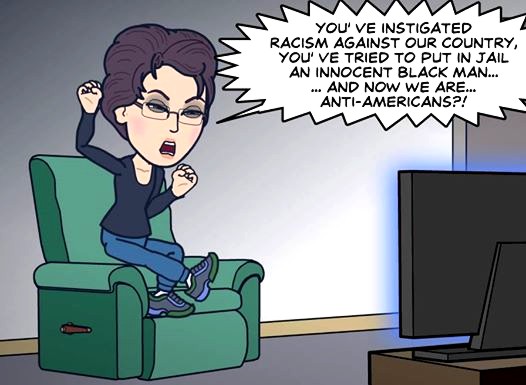
(a StripBit comment by a poster on a Facebook group)
Criticism of Giulia Bongriorno pointing out her hypocrisy is actually not a novelty, it has appeared long since in the press and on the internet.
But it’s hard to understand how someone like her, promoting an image of herself as an advocate for women and for correctness and respect in language and culture, could take such a an egregiously visible false step, come out with such stupid stereotypical rants, only for what looks like an awkward and useless cause.
Conclusion
A note for the record: we may recall Bongiorno has also attacked the Perugian police officers, citing the recording of some of their phone conversations in which they say bad words about the Sollecito family.
We can understand her outrage (at least we could, if only she were not the hypocrite she is) but at the same time we can’t fail to notice that she “forgot” to mention another half of the phone call recordings.
Specifically those where the members of the Sollecito family were speaking about the police officers; and the kind of language they were using, while attempting to plot “˜under the table’ help from some politician.
Expressing their intent to “˜scorch’ officers and “˜destroy’ magistrates, and one person even suggested that if he met Monica Napoleoni on the road, he would kill her by “˜running over her with the car’ then flee without telling anything, pretending that nothing happened.
Never mind.
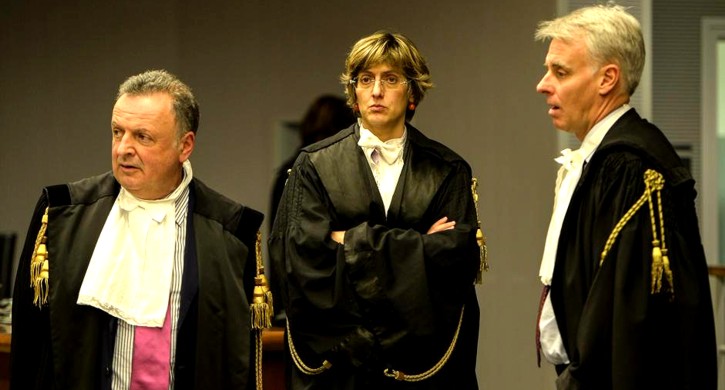
After these last sparkles and the knife waving Bongiorno’s performance was over. In the following day’s hearing it was Maori’s turn. As a really last resort, he was taking on the task of disputing evidence in a more “traditional” way, objecting to points of evidence.
Possibly this revealed even more the extreme weakness of the defensive argument (a commenter called it “˜pathetic’). I did not listen to his argument myself, I only notice that he did not get much space neither in the press nor in the pro-Knox commenting sites; this might be a clue of how unconvincing he might have been.
One thing that however I could learn about it, is about the feeling, the perception that Maori pointed out even more the separation between the two positions of Amanda Knox and Raffaele Sollecito.
A hint about this comes in the words of a journalist who was questioning Alessandro Nencini in the lounge immediately after the verdict: the journalist pointed out how Sollecito defence “tried to split the positions of the two accused”.
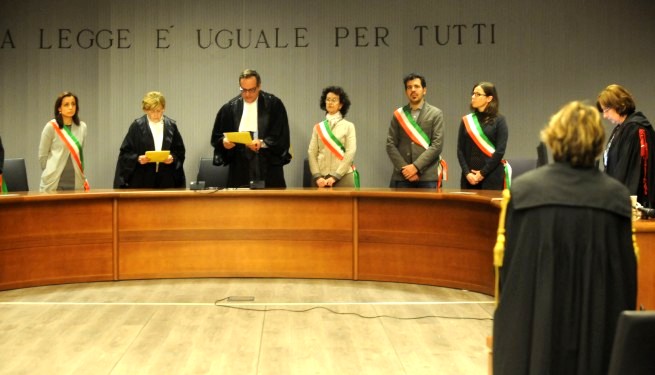
This mild attempt of a separation was the last act by the defence. As for Raffaele Sollecito himself, we were left with his rather different claim, his book where he described himself as sticking to a “˜honour bound’.
He reportedly bragged about this also with his ex-girlfriend Kelsey Kay, who described him as feeling very entitled because of his loyalty to Amanda Knox and believing she owes him a vital a favour; but Knox won’t even respond to his messages.
Then, we had his final admission in an interview that his friendship with Amanda Knox has “˜deteriorated’, because apparently Knox in practice no longer supports him as before.
If his defence advisors understood that they needed to somehow “˜separate’ his position from Knox’s at any cost, despite his plea, to suggest he may be implicated but just “˜less’ guilty, we may only agree with them on this. It would also be convenient for him to confess even if he shared the same degree of guilt of Knox.
Sadly, instead he still felt compelled to offer further lies and changing stories such as”˜I noticed no blood on the bathmat’ when questioned by Kate Couric; he offered again a story of pricking Meredith’s hand while cooking together at the cottage.
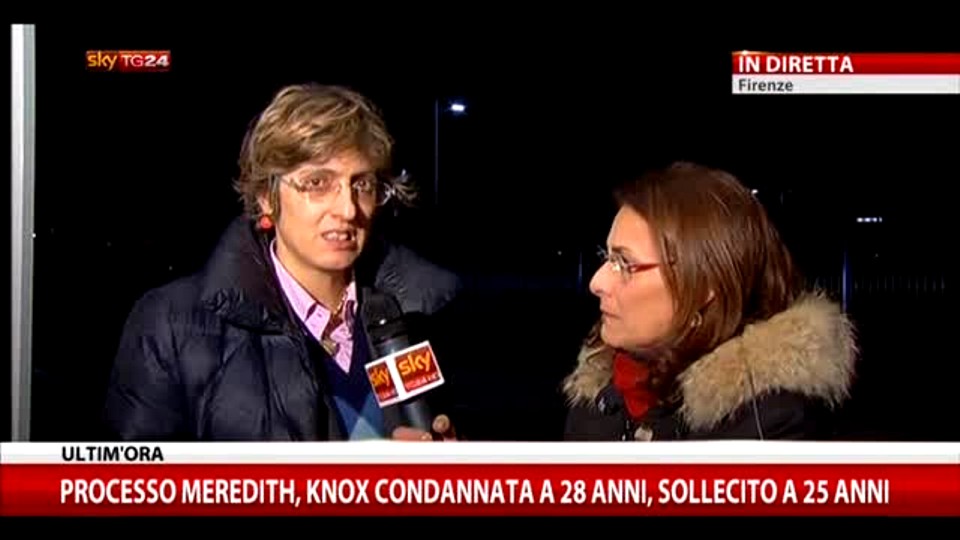
Other murderers, who committed even more heinous crimes, have recovered and rehabilitated themselves after time spent in prison; even some of those deemed among the worst serial killers managed to do this by expressing remorse ““ for example the rather psychopathic “˜Ludwig’ (Furlan & Abel) killers.
Sure after the years he will spend in jail for the gang-like crime he is found guilty of, there would be a possibility for a “˜casual murderer’ such as he is to be perceived as rehabilitated. But to see him as “˜less guilty’ or as “˜rehabilitated’ would be impossible as long as he remains silent or denies.
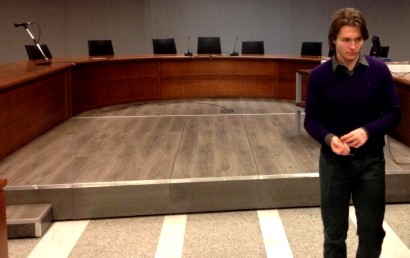
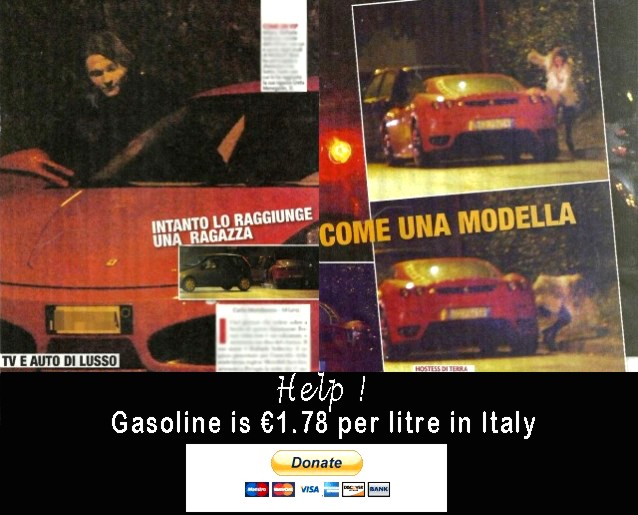
Wednesday, February 26, 2014
How Claims By Perpetrators & Their PR That THEY Are Victims Get Equal Pushback
Posted by Peter Quennell

[Florence prosecutor Giambartolomei will soon confront many false claims ]
To the considerable pain of victims and their loved ones, Italy’s has become one of the most pro-defendant justice and penal systems in the world.
That doesn’t mean that it has become a complete pussycat. Push it, and it usually pushes back harder in its search for the truth. And the quality Italian media goes along.
Time and again the ill-conceived short-term PR and legal tactics for Knox and Sollecito based on a hurricane of lies have left them in terms of the ultimate end-game worse off than they were before.
Judge Matteini and Judge Micheli (the judges in 2008) both took firm lines with the copious evidence and the psychological tests of AK and RS in front of them.
Both judges took a line as firm as the prosecution (as firm as the “evil Mignini”) in concluding that there was a drug-fueled hazing escalating to murder with sexual aspects (however short the timescale of the intent).
[Ed note: See comment by Yummi below which explains the above a little differently. PQ.]
Though his panel of judges voted unanimously for guilt, Judge Massei in 2009 did take a somewhat less firm line in the sentences, after observing one daffy defendant and one very nervous defendant sitting in front of him for nearly a year. Judge Massei for no especially convincing reason
(1) pinned the initiating of the attack on Rudy Guede (really?!) and
(2) handed Knox and Sollecito (and thus Guede) quite a break with his supposed “mitigating circumstances” (the duvet over Meredith’s body) resulting in 20 years lopped off their combined sentences.
Both the defenses and the PR were weak and largely futile in that year. But come 2010 the dirty tricks moved into overdrive.
Cassation reverted to the firmer line in January 2011 when it ruled on Guede’s final appeal: Guede was a party to the murder, but copious evidence proved he did not act alone.
The Hellmann appeal court and DNA consultancy and verdict of 2011 were corrupted (counter-measures are still quietly playing out) which fully explains its startling soft line.
Thereafter the Italian courts observed the illegal blood-money binge with the essentially fictional books of Sollecito and Knox, and two years of them each claiming to ill-prepared interviewers “we’re the real victims” on TV.
Cassation observed all of this, annulled the corrupted Hellmann court verdict, and issued instructions in June 2013 to the Florence appeal court to ensure that the firm line should be maintained. Unsurprisingly, we have seen a firm line from the chief prosecutor (Crini) and a seeming firm line from the lead judge (Nencini) in recent weeks.
In the rest of this year Italy will see at minimum these events where the court’s firm line will go on and the babbling and unhelpful legal and PR tactics may finally dry up.
- 1) RS and AK continuing to babble for a while on TV as they each dig the other one deeper. Sollecito has just said that his saliva or sneezing may explain why his DNA was on the clasp of the bra.
2) The sentencing report of Judge Nencini is due at the latest on 30 April and he seems likely to give space to rebuttals of any bizarre new claims made by Knox and Sollecito before 30 April like the one just above.
3) The obstruction of justice trials of witness Luciano Aviello and incessant meddlers Mario Spezi and Frank Sforza will continue, probably though into 2015. Each of those trials could result in others (like Spezi ally Doug Preston and Sforza allies Bruce Fischer and Steve Moore) being declared at minimum persons of interest if not actually charged.
4) Florence prosecutor Giambartolomei Firenze (image above) may soon be announcing which passages in Sollecito’s book Honor Bound criminally defame Italian officials or deliberately miscontrue hard facts in evidence in an illegal attempt to to poison public opinion against the court.
5) Similarly soon after on Amanda Knox’s book with the surreal title Waiting To Be Heard (and on Knox articles and interviews in Oggi) by the chief prosecutor in Bergamo.
6) Cassation’s First Chambers should be the one to handle Knox’s and Sollecito’s final appeal. They handle murder cases and they issued the guidance to Florence in 2010.
7) If so, they should take note of such revelations by way of Judge Nencini’s and Prosecutor Crini’s reports; and this next autumn or winter may finally declare a firm “confirmed guilty” final-appeal outcome and invite Knox to come back.
And when prosecutor Giambartolomei Firenze announces which claims are radiocative, hopefully a major hush will come over Heavey, Fischer, Bremner and Moore.
Monday, February 24, 2014
Power Shift In Italy Very Unfavorable To Anyone So Stupid As To Thumb Their Noses At Italian Justice
Posted by Peter Quennell
Meet 39-year-old Matteo Renzi
Mr Renzi was sworn in by the President of the Italian Republic on Saturday as the new Prime Minister of Italy. As a top German newssite remarks, he is looking like a much-needed breath of fresh air.
Mr Renzi is colorful and dynamic and very popular, and may become one of the most effective leaders in recent Italian history and a major player on the world stage. Mr Renzi comes from FLORENCE where he was the popular and effective mayor.
Unlike the Berlusconi faction in parliament (which once included Giulia Bongiorno) Mr Renzi is a big friend of law and order, police, and justice. In the image at bottom you can see him opening the huge Palace of Justice in Florence with all the top officers of the court who just organized the appeal.
This is very bad news for Sollecito and Knox and their foolish gangs, as Mr Renzi will be very unlikely to look kindly on that same Florence court - and any court in Italy including, especially, Cassation - being flouted by convicted perps and made to look weak.
If the new Minister of Justice sends an extradition request to his desk, you can bet that he’ll send it on to the United States. And the US, very keen to stay on good terms with Italy as one of its 2-3 most reliable allies, will exhibit little if any resistance to the extradition of Knox.
More bad news for Sollecito and Knox
The sardonic Italian media is paying very close attention to the ongoing game of each of them pushing the other closer to the flames, and the almost-certain prospect of the two of them and Rudy Guede explosively flying apart.
The Italian media is picking up on signs that Sollecito has become highly resentful at his on-again off-again rejection by Knox, especially as many or most in Italy believe it was Knox who wielded the big knife that killed Meredith to which the other two had maybe not signed on in advance.
There are additional pressures headed down the pike. First, Rudy Guede will be given brief study leaves soon, and under Italy’s new “clear the over-crowded prisons (somewhat)” law Guede could even soon see himself released and free to talk.
Plus the investigators examining the criminal defamation of the justice system and officers of the court by Knox and Sollecito in their exceptionally foolish books are believed very close to announcing that a case against them has been made.
Sollecito’s father on national TV has already admitted that Raffaele lied about a deal to get him off, and this on Knox seems an open & shut case. Knox and Sollecito might face additional sentences of 3 to 7 years if they keep provoking a hard line.
Here are two articles translated by Miriam which summarise (not perfectly in our terms but good enough) the signs of the growing divide and the evidence that will see Knox and Sollecito back in prison.
Amanda Knox Will Return to Italy and Go to Jail, as Will Raffaele Sollecito, While Rudy Guede Will Be Freed
This scenario is not only plausible, but seems to be the natural outcome of the last sentencing of the Mez case. Few believe that the Corte di Cassazione could overturn, again, the verdict of the Corte d’Assise d’Appello of Florence.
So Amanda Knox will return to Italy and go to jail. For Amanda Knox, “her extradition is quite possible” Christopher Blakesely say without equivocation. He is one of the main experts on such penal proceeding in the United States.
The day after the verdict of the Corte d’Assise d’Appello of Florence, Giovanna Botteri, the RAI correspondent in the USA, reported something similar, underlining that Amanda rushed to CNN to cry all her tears didnt help.
Knox uses even the social networks to scream again her innocence, but the law says something different.
Even Italian popular opinion seems not in Amanda’s favor : Perugia, through the social networks, has literally screamed its disagreement and displeasure against Amanda (read: L’Urlo di Perugia: a Facebook page against Knox: from the people of Perugia)....
Rudy is at the moment the only one sentenced in jail…. How does Rudy reconstruct that night? Rudy swears to having consensual sex with Mez.
After the intimate relation Guede went to the bathroom and from there he heard her scream, rushing to her room he found her in a pool of blood, and tried to help her. Realizing that Meredith was dead, in shock he ran away.
On the plausibility of this reconstruction, the judges had numerous doubts, to the point of finding Guede guilty and sentencing him.
This reconstruction, according to his lawyers, explains not only the biological traces of Rudy all over the crime scene but also his flight.
How does Amanda reconstruct that night?
Amanda continues to sustain that she did not wield the knife that killed Mez, that she heard her scream while she was in the kitchen and that she covered her ears like a scared child.
The “whys” are many and heavy. Why did Amanda accused Patrick Lumumba, incarcerated for 14 days while innocent, due to her ignominious accusations? Why on the knife used for the murder are there traces of Mez and Amanda?
Knox DNA was on the handle of the knife that killed Meredith: only because she used it to cut potatoes? The alibi of the potato has always been used by Knox and her lawyers, but it is plausible?
And Raffaele Sollecito?
One of the most decisive evidence against Sollecito in the first trial was the bloody foot print on the bathroom math. In the appeal process that footprint was challenged, it was said that it could be not Sollecito’s and was ascribed to Guede with benefit of doubt .
Now it seems certain that Rudy was wearing shoes ,as is demonstrated by other prints at the scene of the crime, thus the bloody footprint goes back to being ascribed to Sollecito.
Why is Rudy Guede in jail while Amanda and Raffaele are on the loose?
After the verdict of the Corte d’Assise d’Appello of Florence the appeal to the Cassazione, was announced, while waiting for the Cassazione, the guilty Raffaele Sollecito had to hand over his passport in order to make it impossible for him to leave Italy.
Right after the sentence Sollecito was stopped in Udine about 60km from the Italy/Austrian border and about 40km from the Slovenian border.
Before the verdict of Corte D’Assise d’Appello of Florence Sollecito was a free man, and therefore legally in possession of a passport and the right to cross the border.
Sollecito, instead of waiting for the verdict in the court room, around 12 o’clock that day left with his new girlfriend and arrived in Udine [in north-east Ital]..
Around night time during a snow storm the two of them took refuge in an hotel , and the owner recognizing Sollecito by name, alerted the police that promptly arrived in order to confiscate Sollecito’s passport as decided by the Court.
Sollecito told the media that he had no intention of fleeing the Country.
One can ask what Sollecito was doing in Udine then, a few hours after his guilty verdict. To excuse Sollecito one can perhaps say that the young man was overpowered by anguish and fear, in fact up to today
Sollecito had never seemed to want to evade justice, instead he was usually in the Courtroom.
Amanda in contrast was not sanctioned with any precautionary measures. She arrived in America as a free citizen after the not guilty verdict.
Now, if and when the Cassazione confirms the verdict of the last proceeding, America needs to extradite Amanda and remit her in the hands of the Italian Justice…
America is tied to Italy by sanction accords by name of international laws, thus if the Cassazione upholds the guilty verdict, Amanda must return to Italy. Nothing makes one think that America could oppose an extradition.
Rudy Guede is the only guilty one in jail at the moment. His detention was confirmed after a fast track trial, decided by his layers, and his detention was 16 years in jail. (with time off for the fast track trial)
Not many know that while the doors of the prison may soon open for Amanda and Raffaele,, for Rudy instead “freedom” may be close by.
Thanks to the new decree passed last December by the Parliament, Rudy could leave the prison where he is detained. Guede is one of 3 thousand detainees who could benefit from the “empty the prisons” decree.
Raffaele Sollecito and Amanda Knox are close to a break up after the sentencing..
Raffaele wrote Amanda a letter saying: “Amanda I am tired. I don’t want to be punished, neither do I want to continue to give justifications for matters that concern you and not me”.
Amanda says “I understand him but: I want to say that Raffaele is not my slave and I am not his oppressor. Raffaele has many reasons to be resentful, but not with me.”
The bond between the two, accused of the homicide of Meredith Kercher, is cracking. A bond that lasted from that horrible night of November1st 2007, when in a house in Perugia, via della Pergola, their English friend was savagely killed.
Looking at a concrete possibility that the Judges of the Cassazione will confirm the sentencing which condemned Amanda and Raffaele to 28 years of jail for her and 26 for him, the two ex-lovers are starting to distance themselves from each other.
Amanda took a picture of herself holding a sign that read “we are innocent” so as to underline a common faith, from which Raffaele can’t dissociate. Not anymore.
Raffaele after six years may be starting to understand that being Amanda’s “fiancé” did not help him at all. He said this to Giulio, in an interview a few months ago, and now in an interview to CNN:
In the Judges head I must be guilty because I was Amanda’s boy-friend. It does not make any sense for me. According to the Judges because in some way I supported Amanda, I must be implicated. According to me this is aberrant. My standing has not been just ignored, but completely forgotten. In all the proceedings I was not part of them unless for the scientific investigations.
For many, many hearings the topic was my DNA, but nobody said nothing of the reason why I was accused of the homicide except the fact that I was Amanda’s boy-friend and because I was with her very often and spent many nights with her, I had to be in some way connected with the homicide.
Is Raffaele’s defense thinking of ditching the girl? Is Raffaele ready to tell the truth of what happened that night? Now Raffaele is in Bari, and is thinking over what happened to him. He reveals:
I discussed with my friends and family the possibility of going abroad a year ago, but I cannot accept the fact of leaving all the people who are dear to me for a theory. I had no motive to hurt Meredith Kercher.
Now I have no light in my future. They took away my passport and I.D. card, and I do not know if I can realize my dreams, or anything I want to do. I do not accept that my future is destroyed.
Too often, though, Amanda and Raffaele forget to mention that Meredith’s life really was destroyed.
Against Amanda and Raffaele there are scientific evidence, bloody footprints on the floor, DNA on the bra clasp and knife, and the many contradictions in their alibis.
From the beginning their behavior caused the carabinieri to be suspicious of them.
Without forgetting the spontaneous confession of Amanda of being in the house while her friend was being murdered. “I have a vision of being in the kitchen, covering my ears while they kill her.” She even gave the name of the killer Patrick Lumumba, her boss, who was then discovered to be innocent.
The attempt to divert the investigation, pointing the finger against an innocent man, is evidence of the quilt of Amanda.
Even Raffaele changed versions more than once. In one of the interrogations he said Amanda was not with him that night and arrived at his apartment in the early hours of the morning. He then said he smoked too much marijuana and could not recall what happened that night.
In the meantime Rudy Guede, 27 years old, condemned to 16 years for the murder of Meredith Kercher, with others, writes:
Now that my verdict is definite, for too long the judicial reasoning have been subjected to a continuous and willful manipulation and alteration of the data of the proceedings… I would like to point out that I do not accept being labeled as a homeless man, drifter, and a thief; when instead I had a splendid family and precious and clean friendships in Perugia.
Amanda Knox’s defense team wants to pass him off as a habitual thief. Rudy adds: ” “Meredith’s house was turned upside down, someone simulated a break in. I was not condemned for this simulated break-in.”
If it was not Rudy, then who?
Wednesday, February 19, 2014
Our Reviews Of The Painstaking BBC-3 Report First Aired In The UK On 17 February 2014
Posted by Our Main Posters
Review by SomeAlibi
Watching “Is Amanda Knox Guilty” was a funny thing. I suspect for people following the case closely, on either side, it was a sobering experience. Not because it changed perspectives, but simply to see how quickly one hour passed and the necessary trade offs that had to be made to fit within that schedule. The opportunity cost was a level of detail to which in-depth followers have become accustomed.
Just one example: Sollecito and Knox’s partial alibi that they were checking their emails on the night of November 1st was explained as being challenged by two broken computers. Perhaps, (although unlikely to be the material issue) but where was the much more salient fact that their ISP records showed that was conclusively untrue? Where was the challenge: if you say you’re checking emails to establish part of your alibi against a murder and it is shown to be absolutely untrue, what does that suggest…?
There were many other “clinchers” that had to be let go in the name of brevity. But it wasn’t that sort of documentary - it was neither a case for the prosecution or a case for the defence: it put the main suggestions at the level of detail that was possible and it allowed both sides to speak to the points at that level of detail.
I find it interesting that there has been such a howl of bias from those supporting Knox and Sollecito. Objectively there’s no good ground for it: the documentary allowed both sides forward in equal measure and no pro-justice watcher would celebrate it as a pro-conviction piece.
The arguments were balanced, the video, audio and picture quality eye-opening. For those on the other side, their markedly different reaction appears to be that the documentary has broken the taboo that The Evidence Shall Not be Told. The idea that there is an easy-to-consume piece that puts forth the case and defence equally is seen as a disaster.
The campaign for Knox continues to be obsessed, beyond all things, with trying but now failing to make sure the public doesn’t know the basis of the case. For a long time they hoped to drown out the multitude of terribly inconvenient truths within it by screaming “no evidence”. ‘Is Amanda Knox Guilty’ put the lie to that conclusively, but fairly, and now many hundreds of thousands, perhaps soon to be millions will ask themselves why those supporting Knox and Sollecito have had to adopt this tactic at all.
If they really are innocent, why has the case against them been so comprehensively white-washed in the US?
The conclusion, is rather simple and I saw it encapsulated on a large television screen last night with the repeated clips of Amanda Knox and Raffaele Sollecito outside the cottage kissing and “comforting” each other: there for a fraction of a second, shown several times, is Amanda Knox, unable to stop herself glancing at the camera filming her and stealing her gaze away again very quickly pretending she hasn’t.
It’s a look that says everything: furtive, pretending it didn’t happen, immediately covering up in a way that poses a stark proposition: why on earth would you do that if you had nothing to hide? And like so much of the multiple collapsing alibis and non-working answers and the desperately dishonest fingers-in-the-ear “no-evidence” pretence of those supporting her, is a proposition that can withstand no scrutiny.
Review by SeekingUnderstanding
What a relief to watch a very clear and unbiased narrative. The quality of the visual information was top rate - seeing so much original footage, and presented as it was in a logical time sequence.
Even though I was already familiar with the evidence, including the photographic material, I found it very helpful to see it all presented in this way. I appreciated, too, hearing and seeing the excerpts in original Italian (along with English translations). It added even more authenticity.
I hope that, at long last, this will have helped some - or hopefully many- people to see that the two ‘camps’ in this case do not divide into AK supporters and AK ‘haters’. There are the FoA and their followers ...and there are the others who seek the objective truth and justice.
If hate has been generated in some quarters, then the Knox (and Sollecito) camps need to look to themselves and their own behaviour. This programme was important in the tone it set.
I actually found it to be quite lenient towards the defence on a number of counts.
There were several instances where the defence point of view could have been strongly countered by known and established facts, but, bending over in fairness, these were left unanswered.
Here are just four instances :
1) In the discussion around the blood and DNA left in the bathroom - Dr. Gino’s assertion that ‘the blood/DNA ‘could have come from anywhere’ might have been countered with AK’s own declaration that the bathroom was previously clean. Dr. Gino also suggested a very improbable scenario of ‘it could be saliva’ (on the bidet?). Cassation emphatically said that it must be shown HOW any suggested contamination could have occurred.
2) There was a missed opportunity in discussing the knife presumed to be the murder weapon to mention Sollecito’s lame, unreal excuse of ‘Meredith pricked her hand’ etc.
3) Anne Bremner stated ‘Amanda could not have turned overnight…into a murderer’. Attention could have been drawn to many things, both physical events (her predilection for cruel pranks, including a staged burglary in the US, and wild parties, etc), and also many psychological indicators that would have clearly shown how her behaviour has, in fact, demonstrated consistency.
4) In the discussion re the bra clasp, the delay partially being caused by the defence themselves was not mentioned. Also, detailed discussion re the one bare footprint on the bathmat was omitted.
Since there is, in fact, so much evidence, it must have been difficult to chose and balance what did go into the hour long programme. All in all, I feel Andrea Vogt and her team worked hard, and did very well to let the facts speak for themselves.
I hope it will lay a few fictions and myths to rest.
Review by Earthling
What is the “Amanda Knox trial” (really the Meredith Kercher murder trial) really about? Is it about an innocent 20-year-old pretty white girl being railroaded by the medieval Italian justice system?
Or is this actually a murder trial, about the fact that a beautiful, intelligent, ambitious young woman, innocently trying to improve her life by study abroad, was brutally murdered?
I believe it’s the latter, and the BBC3 production gives us one of the first truly balanced reports on this trial.
The filmmaker starts from the beginning, and takes us through the murder, investigation, and various trials and appeals up to the present day. Instead of the breathless “Perils of Penelope” tone (toward Amanda Knox) that most such previous “documentaries” have taken, this one takes a sober look at the actual evidence.
Did you realize that there are luminol-revealed bare footprints in Knox’s size in the apartment? Luminol reveals blood and a few other substances; but those substances can be ruled out because the test was done six weeks after the murder, by which time those substances would have dissipated.
Blood doesn’t dissipate. This documentary shows you those bloody footprints in all their creepy glory, something never shown on American TV before.
“Is Amanda Knox Guilty” also speaks of the actual DNA evidence in the cottage linking Knox to the murder, including five mixed-DNA spots (Knox and Kercher) that tested positive for blood. Both prosecution- and defense-oriented experts are allowed to comment on this evidence, and the viewer is allowed to make up his or her own mind.
My one criticism is that a lot of the evidence against Knox (witness statements, cell phone data, fake break-in) is skimmed over or not even mentioned. Also, because the documentary quotes Rudy Guede’s position at length without any contradictory narrative, it is confusing as to whether the filmmaker might have believed him.
In the end, the filmmaker says, he was convicted of participating in the group murder. However, a stronger statement against his “I’m entirely innocent” defense would have been good.
Other than these quibbles, this is the best documentary on the Meredith Kercher murder case that I have ever seen.
Review by ZiaK
I watched the BBC programme on the Meredith Kercher case hoping for a more balanced view of the case than has been presented in the English-speaking media to date.
The documentary does present some of the evidence against Knox and Sollecito - including the bloody footprints, the mixed blood/DNA traces in the bathroom and corridor, the bra clasp, the knife DNA evidence, the strange timings of phone calls to police, the unlikelihood of the “break-in” being anything other than staged - but omits to point out that none of the other flatmates’ DNA was found in the blood traces, so saying that “it’s because Meredith and Amanda shared a flat” is misleading.
Nor does it point out that, although the murder knife was found in Sollecito’s flat, none of HIS DNA was found on it: it had only Amanda’s and Meredith’s DNA.
The programme didn’t cover the cell-phone evidence, showing that neither Knox nor Sollecito were where they said they were, at the times that they claimed. The programme also repeated the “Friends of Amanda” PR soundbites, such as “there was no evidence of Amanda in the murder room” - whereas the fact that her footsteps tracked blood OUT of the room are actually evidence of her having been present IN the room before it was locked (i.e. at the time of the murder).
Furthermore, in my opinion, the narrator’s voice seemed to evince sympathy towards Amanda, rather than describing events with a passive or objective tone of voice.
As one of the translators who has participated in translating case documents (such as the judges’ reports describing why they came to their decisions), I am only too aware of the extent of evidence against Knox and Sollecito, and I would like to see knowledge of this evidence become more widespread throughout the English-speaking world.
The BBC programme is a step towards this, but in my mind, only a very small step. I hope the pace will pick up soon, and more objective and extensive knowledge of the true facts of this case will be made available to everyone so they can form a rational opinion of the case based on true understanding.
Review by Cynthia
I’ve just watched this, and it’s very good - with a huge amount of footage hitherto unseen (directed by Andrea Vogt).
For what it’s worth, I note the following points:
1) There’s no mention of Meredith’s friends who heard Amanda say ‘she fucking bled to death’ before the fact was known to anyone else. Perhaps they didn’t testify, being too distressed? If so, it’s a great pity, because it seems a veritable clincher that hasn’t been used at all.
2) The bra DNA arguments are quite extraordinary. If we can determine that we all have Neanderthal DNA (tho’ I know a lot of American fundamentalists don’t believe that mankind goes back more than 6,000 years!) I can’t for the life of me see why DNA would be unusable after a poxy delay of 12 days ...
3) The argument that the Luminol traces may indicate not barefoot treading in blood but in bleach seems absolutely unbelievable to anyone who does housework (like me!) Bleach is horrible stuff, and you really, really don’t want to be getting it on your bare skin. Even Amanda, with her vestigial domestic skills, would have noticed if she’d trodden in it.
4) Bremner says Amanda was an honor student. She wasn’t; she had funded herself (not that that’s discreditable). (Also, are honor students unable to write cursive script? The shots of her handwriting show that she can’t do joined-up writing. [Or thinking.] I don’t know whether the phrase exists in American English, but not doing joined-up writing is a term of great intellectual contempt in English.)
5) We saw Amanda’s ‘mask’ speech. This is really interesting - who would even think that masks were being put on them if they weren’t using them themselves?
6) The programme mentions the little-reported fact that another, smaller knife found at Sollecito’s also had Meredith’s DNA on it.
7) The film omits to mention Hellman’s lack of any experience in criminal trials.
8) Every shot of Amanda in the film has her talking about ‘me’ and ‘I’. She never, ever mentions Meredith - it’s all about HER suffering. She never even says ‘the murderer is out there - I wish you’d stop persecuting me and get them’.
Presumably this is because Guede is supposed to be the sole murderer - and nobody seems in the slightest bit worried that there’s no murder weapon with HIS DNA on it! (Yes, there are his turds - but that wasn’t what killed Meredith.)
9) FOA has used the fact that the recent jury took 12 hours to deliberate over the verdict as an indication that they couldn’t agree. But why not just that they were being extremely careful and re-examining everything?
10) Finally, just an observation: Maresca speaks the most beautiful Italian - you can hear every word calmly flowing past.
Review by Miriam
Much appreciated. Outside of the Porta a Porta transmissions on the case, the best I’ve seen.
I understand they had to give both sides, but I felt that the defense came out on the losing side. I thought it funny that it was implied that since they only tested for blood it could of been saliva.
I don’t believe even her supporters would argue that Knox was so quirky as to brush her teeth in the bidet! Or maybe she spit in the bidet, in which case Meredith would have had every reason to complain about her bathroom habits!
Now if only this or something like this would air in the U.S.
Review by Sara
This is actually one of the most objective and well-researched reports I have seen on the case and I am very happy that BBC has managed to be so unbiased.
It presents both sides of the story equally well and does an excellent job of countering the extremely silly “no evidence” argument that the FOAkers like to repeat at equal intervals.
Regardless of what one believes, I think the documentary will at least succeed in convincing most people that there is indeed sufficient evidence against the two of them, and Italy’s judicial system is not crazy to convict people without any evidence.
My favourite part was when the defense DNA expert (can’t recall her name) tried to explain away the mixed blood evidence by saying that one of them could have had a nose bleed, and the other could have cut her hand in the same place leading to mixed blood.
Come on already, what are we? Kindergartens making excuses for not handing in homework? What is the possibility that both of them would bleed in exactly the same places not once or twice but multiple times? I think anyone with a bit of sense can see that they are clutching at straws.
However, I was a bit disappointed that few things were missed out. For instance, the fact that Guede’s footprints led straight out of the house, the fact that Amanda’s lamp was found without any obvious reason in Meredith’s room, Amanda’s extremely odd midnight call to her mom that she conveniently “forgot”, her million showers despite her concern towards “water conservation” etc.
Sollecito’s multiple changing stories were not really elaborated upon (the story in which he went to a party, the one in which he checked emails, the one in which he pricked Meredith etc etc).
Also, inconsistencies between their accounts of various events could have been pointed out (Was Filomena’s door open or close? Did AK call Filomena from the cottage or from Sollecito’s house? etc).
Witness accounts were not given any screen space either. I think touching upon these would have made the documentary even more impressive.
That said, I understand that the team has done the best they would within the limited time they had, and everything just cannot be accommodated within one hour.
So, all in all, kudos to the team and BBC for a job well done.
Review by Odysseus
I though it was a very competent overview of the case. After so much pro-defendant spin in the MSM (no doubt engineered by the American defendant’s PR outfit), it was refreshing to have a sane, measured and rational presentation. The victim deserves no less.
Congratulations to BBC3 and to the programme makers. It’s good to know that the BBC of blessed memory hasn’t been entirely dumbed-down nor intimidated by “partial outside interests”, the latter being director Andrea Vogt’s own description of the forces intent on muddying the waters in this case.
Tuesday, February 18, 2014
Congratulations To The BBC For A Report Emphasizing The Sheer Extensiveness Of The Evidence
Posted by Our Main Posters
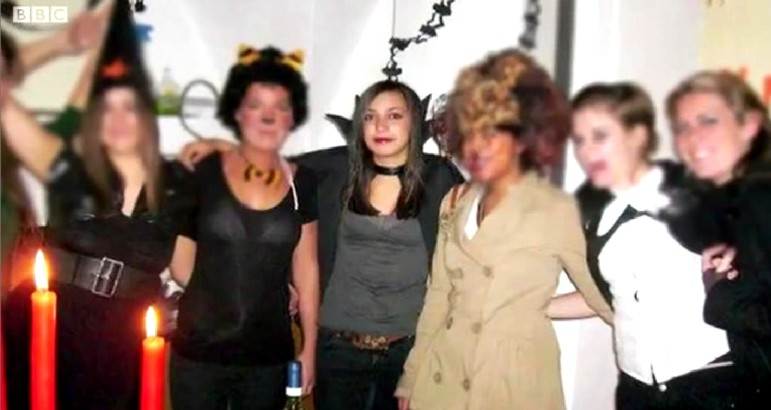
[From the BBC report: Meredith the night before the cruel, deadly attack with her Halloween friends]
This is the painstaking and obviously expensive report by Andrea Vogt and Paul Russell with interviews in London, Seattle and Perugia.
It was aired by the BBC on 17 February. Considerable time is allocated to defense lawyers and experts and the Knox family and Ann Bremner of the FOA taking their best shots at explaining how Knox could maybe have not been involved.
Still, the sheer mass of the evidence remains as the 80,000 pound elephant in the room, lacking any hint of a realistic alternative explanation. Three people committed the horrific attack, including Rudy Guede and two others.
Only Knox and Sollecito remain pointed to by dozens of evidence points as those two others. Not one single evidence point indicates anyone else was involved. The Masssei trial court got it right as the Nencini appeal court just confirmed.
We will enquire if we can embed the hour-long video. But as it may be picked up by US and other foreign media outlets, we will start by simply summarizing it soon. Assessents by those who have already seen it are welcomed.
Friday, February 14, 2014
Hard Questions By Italian Journalist Giuseppe Castellini For Sollecito
Posted by Peter Quennell
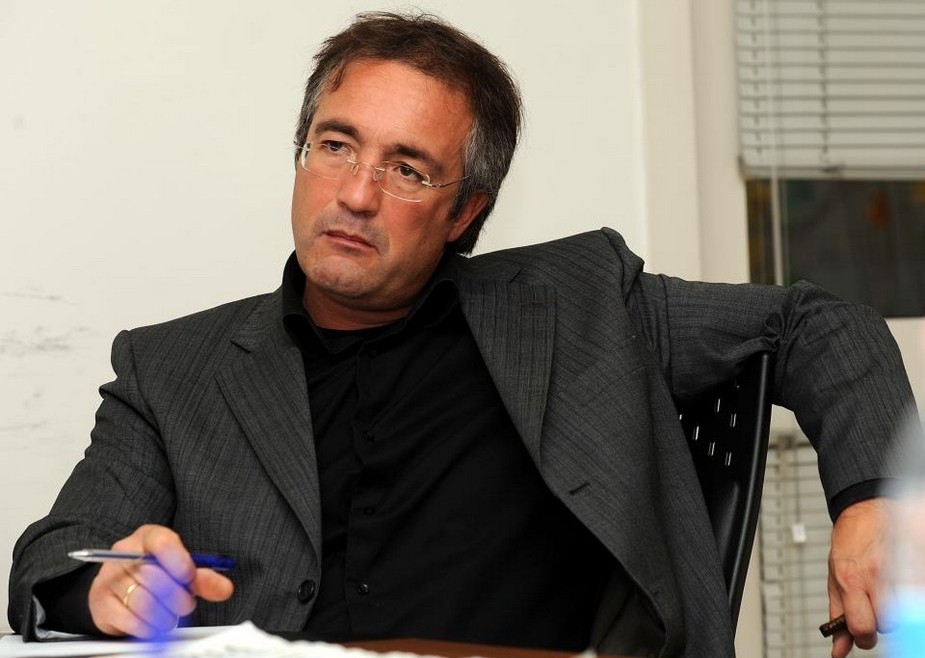
[Above: Giuseppe Castellini of Giornale dell Umbria has long exposed the Knox/Sollecito lies]
1. Overview Of Italian Media Takes
The fast-growing satires of Knox and Sollecito in Italy described in our previous post are not just emerging in a vacuum.
The many tough crime-show comperes and crime reporters in Italy have rarely let Knox or Sollecito get away with any of their lies. One example was when Bruno Vespa, the host of Porta a Porta, Italy’s most popular crime show, forced Francesco Sollecito to admit to Italy that his son lied extensively in Honor Bound. Another example is when Oggi published some of Knox’s lies and they were rapidly exposed. For seemingly endorsing Knox’s lies Oggi will face trial for obstruction of justice.
There are countless other examples where Sollecito and Knox have been exposed as liars. The super-sharp editor of the Giornale dell Umbria, Giuseppe Castellini, has just published this challenge to Sollecito who had absurdly had claimed that nobody ever wanted to ask him any questions in court.
2. Giuseppe Castellini Questions RS
The translation is by Miriam.
Murder of Meredith: a few questions for Raffaele Sollecito
Raffaele Sollecito, found guilty and condemned to 25 years by the Appeals Court of Florence, for the murder of the English student Meredith Kercher (for the same crime Amanda Knox was also found guilty and Rudy Guede is already serving a definite sentence of 16 years) has stated that he was never questioned in court, because no one ever asked him.
For the record and in order to have a complete picture at, it should be remembered that during the investigation, Sollecito twice took advantage of his right to not respond to the questions of the PM Mignini.
So if it’s true that the prosecutors, in all the trials never asked to question him in court, neither did he ask to be, limiting himself to giving several times making spontaneous statements, without being cross examined.
However, this is not the real point. The fact is that Raffaele could not or did not want to respond to the questions of the investigators.
His version was always brought forth in detail by his lawyers, obviously, but that is not the same thing.
Important questions remain to which Raffaele did not answer directly during cross examination by the Prosecutors. Let’s try to summarize some crucial unanswered ones. Who knows if Raffaele will ever decide to respond in detail right here on these pages even though ““ at the moment ““ it seems improbable. We address him directly, sure that he reads these pages.
1. The first time that you were questioned in Questura you said that the first of November 2007 (Meredith was murdered the night between the first and the second of November) after a walk through downtown Perugia (before that you and Amanda have been in the house in via della Pergola). You came home around 08.00pm while Amanda come back much later around 01.00am, you then changed your version saying that you had always been together. Your first statement seem like a distancing from Amanda, in those hours nobody knows what she did, while the second one has a complete different flavor. Why did you radically changed your version?
2. It’s proved by the findings (even if your lawyers contested it) that the computer in your house was activated for about half an hour from 05.32am till little after 06.00am of the second of November. For the experts of the Police it was certainly a human interaction. You, instead declare that you and Amanda were sleeping. So who was it then that was using your PC at that hour?
3. Your and Amanda’s cell phones were turned off at the same time around 08.40pm of the first of November and they were turned on, practically at the same time, a little after 06.00am of the second of November (at that time you received the “good night” sms sent from your father the night before). How do you explain all this?
4. You stated that you were not in the house in via della Pergola. How it is possible that your DNA is on the bra clasp (17 loci that shows your genetic profile, and for the father of Italian genetics, Prof. Vescovi, that with the current processes are not only enough, but more than enough to match your DNA). And why did luminol revealed a bare right foot print compatible with yours, in addition to the one on the bathmat in the small bathroom? (the size of the big toe, just to point out one thing, is just like yours, while Rudy’s is a lot smaller).
5. Why, if Rudy was the only assassin, in the corridor would he cancel only the bare foot prints, leaving in plain sight always his, but left with the shoe print of his left foot? Doesn’t it come to mind that whoever cleaned up the prints thought to cancel theirs (specifically the ones ascribed to you and Amanda) leaving behind those recognizable as Rudy’s?
6. You and Amanda were seen by the homeless Antonio Curatolo late the night of the murder and Amanda was seen by the shopkeeper ““ that knew you well and already saw you with Amanda ““ enter in the shop at about 07.45am to buy something and go back toward piazza Grimana. You and Amanda say that at that hour you were sleeping in your house. Is there something that can demonstrate this, that up to now has slipped away and that would give you the missing alibi?
3. Questions For RS Of Our Own
We have advanced plenty of questions for the evasive Sollecito of our own. Here are seven examples.
- Questions For Sollecito Do You Stand By Your Smear Of Reasonable Doubt In Italian Law?
- Questions For Sollecito Why Claim Guede Did It Alone When Vast Evidence Contradicts That?
- Questions For Sollecito Why So Many Contradictory Explanations Of How DNA Got On The Knife?
- Questions For Sollecito Did Your Father & Lawyers Pre-Approve This Crazed Rant?
- Questions For Sollecito Can You Realistically Account For The Hard Evidence On The Bathroom Mat?
- Questions For Sollecito Katie Couric, Push Back Against Sollecito’s Bluster And False Facts #2
- Questions For Sollecito Katie Couric, Push Back Against Sollecito’s Bluster And False Facts #1
Wednesday, February 12, 2014
In Italy The Faux Self Pity Of Knox And Sollecito Is Increasingly Becoming A National Joke
Posted by Peter Quennell
Meet Amanda Knox the Perugian Chipmunk version.
Knox’s Facebook page is also being satirised and ridiculed (one message there reads “Perugia Hates You”.) Some may actually believe the rumor that Knox is shopping herself around for salacious movies.
Sollecito being nabbed at the Austrian border because of a quick tip to the police also inspired sarcastic humor in Italy, and several journalists have come up with questions to challenge Sollecito when he gets on the stand, as he so desperately wants or says he does.
We expect some more Italian satire (and maybe not only Italian) and will report on that as well, as this long-needed and much-deserved hit-back against dishonest pandering to media audiences could prove an important trend.
If satire proves the way to stop RS and AK babbling lies daily about the case and Italian justice via every craven media outlet, then well done Italy!! Nothing else seems to work to shut the two up, although their false claims and smears could constitute obstruction of justice.
If Knox and Sollecito want to avoid being spoofed, they have two very easy ways to do so: (1) shut up and avoid the media, or (2) stick to telling the truth.
Admired Feminist Victoria Brownworth On Knox As Ice-Cold And Media’s Hit & Miss Performance
Posted by Peter Quennell
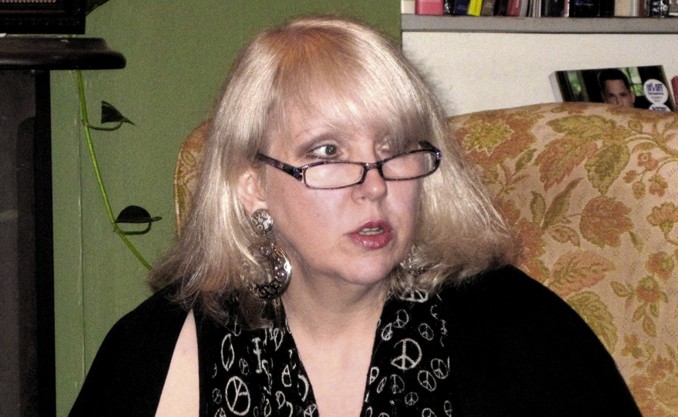
This is a key part (please read it all) from the great Victoria Brownworth’s Trial by Media - The Case of Amanda Knox
Is Knox guilty? Two long, complicated trials have said yes. Knox’s massive PR machine”“much like Simpson’s”“says no. That PR machine also ignores the fact that Knox falsely accused a black man of the murder and that he spent time in prison solely because of her accusation that she saw him take Kercher into the bedroom and heard her scream””while she, Knox, did nothing.
Angelina Antoinetti, Knox’s personal prison guard, told reporters after the conviction on Jan. 31 that Knox has reinvented herself for the media.
“Now she’s become this TV star, who cares passionately about what happened to her “˜friend’ Meredith Kercher, and wants the truth to come out. She’s painting herself as a warm, loving human being, but the Amanda I knew was so composed, I never saw her suffering and other prisoners and staff called her the Ice Maiden.”
Antoinetti said Knox “never, ever talked of Meredith or expressed emotion about her death. Whenever Meredith’s face came on TV she didn’t want to know and didn’t respond. She was impenetrable. Underneath the veneers she remains the same controlled woman I knew well in Capanne prison. She was so composed, I never saw her suffering.”
Antoinetti said that Knox “became attached to me. I opened her cell each morning and shut her in at night. She liked English music like the Beatles and always sang. She had guitar lessons, too.”
Knox was “unlike any other prisoner,” Antoinetti said. “I’ve never seen another girl like her, especially so young. She’s magnetic and manipulative. She had no emotions for people, only books. She never talked to other prisoners, she was only concerned about her world. Even when they freed her after the appeal, she didn’t speak to a single person she had just spent four years with, just walked out.
That’s not human, is it?”
And that is the question for many: Who is the real Amanda Knox?
As with the Simpson trial, the media has played a huge role in the Knox case. The U.K. papers labeled Knox “Foxy Knoxy” while the Italian papers played up Knox’s sexual history and the more lurid sexual elements of the case”“the assertion that the murder was a drug-fueled sex game gone wrong.
In the U.S. ABC News has been a virtual PR firm for Knox, devoting hours of time on both 20/20 and Good Morning America as well as the actual ABC Nightly News promoting Knox’s innocence. Diane Sawyer did a heavily promoted hour-long interview with Knox when she was released from prison in 2011. And when the Jan. 31 conviction came in, on her ABC Nightly News broadcast, Sawyer led with “the American girl” Amanda Knox”“even though Knox is 26. A full six minutes of broadcast time was devoted to Knox”“including video of her singing and playing guitar. When has a national news network treated a twice-convicted murderer in such a manner?
The two media portraits of Knox”“the sex-obsessed sexual manipulator she’s been portrayed as being by the European media and the pristine girl-next-door innocent-abroad the U.S. media has presented conflict, obviously. But what has been lost in the emphasis on Knox as the victim of the story is the actual murder victim, Meredith Kercher.
Tuesday, February 11, 2014
The Much-Demonized Rudy Guede Is Back In The News And Increasingly Threatening
Posted by Peter Quennell
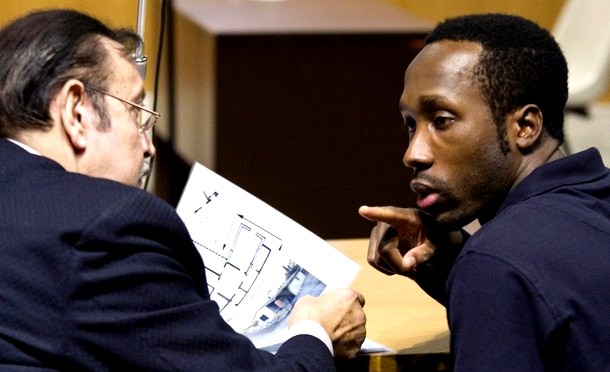
Rudy Guede has long DELIBERATELY been demonized so that the attack on Meredith can be assigned to him alone.
This description of Guede’s early days in the Ivory Coast and Perugia in the excellent Darkness Descending by Paul Russell and Graham Johnson remains the ONLY one that fully checks out. Certainly not that by the dishonest PR shill Nina Burleigh.
Guede wasn’t especially an angel, and some in Perugia were iffy about him. But he had real friends, and up north he held a real job with a real career future, until that prospect imploded and sent him haplessly back to Perugia.
Late in October 2008 Judge Micheli discounted all that Guede ever said about his role in the attack on Meredith in various conversations and statements, and sentenced Guede to 30 years.
But Judge Micheli also concluded that there was no firm evidence either that Guede acted alone or that Guede was a drifter, drug dealer, knife wielder or burglar (Micheli was very sharp with one witness who claimed Guede may - may - have broken into his house).
In 2009 through his lawyers Guede enquired of the prosecution whether he might testify at the Knox-Sollecito trial.
But the prosecutions’ hands were already tied by the indictments and they (rightly) believed they had a really strong case regardless of anything Guede could add.
At the 2009 trial the defenses pussyfooted around and never settled for a firm position on Guede. They floundered in their subdued attempts to prove that Guede or somebody else unknown was the so-called Lone Wolf.
The Lone Wolf theory is really a zombie theory with so many stakes through its heart that no court will ever take it seriously.
Guede’s steadfast fallback position before and since was that he was only in the house on the night of the attack because Meredith invited him to come in and they began love-making.
At his late-2009 first appeal and also at Sollecito’s and Knox’s 2011 appeal before Judge Hellmann, he increasingly firmly pointed the finger at Knox and Sollecito as the murderers.
Guede had been initially inclined to let sleeping dogs lie after he was mysteriously beaten up in the sex offenders wing of Viterbo prison, where prisoners are meant to be kept very safe.
But Judge Massei’s scenario of the attack on Meredith in his March 2010 Sentencing Report, with Rudy Guede as the lead instigator, really bothered him.
And in mid 2010 he became even more bothered when claims were made by a fellow prisoner the baby killer Mario Alessi that Guede confided that he really had committed the murder, along with two others. Not with Knox and Sollecito.
A very angry Rudy Guede in turn wrote a letter denying this which very rapidly went public.
In 2011 there was a tense confrontation in the Hellmann court (which several times descended into chaos) when this letter, in which by now Guede firmly accuses Knox and Sollecito, was read out for him.
Guede stuck to this position on the stand, and he was not required to face full cross-examination by the shrill, frustrated defenses because he was already convicted and no longer the one on trial.
Seemingly fed up with all the dirty tricks against him and the now-incessant Knox and Sollecito mantras in the media that Guede had acted alone, he has come out with another letter.
Italy’s AGI News Service has posted this letter to an unidentified recipient, along with this report.
(AGI) Perugia, February 11 “Against me are being repeated false imaginated reconstructions of the crime for the sole purpose of wanting to denigrate my figure and person, systematically and in a negative way, in the public eye and not just in Italy.”
He apparently also posted what he wrote in his own hand on the Facebook page “Legal processes and their surroundings”...
The letter is on a sheet of notebook paper handwritten and signed by Guede.
“To my regret I am again forced to take a pen and paper and write for the sake of the truth.. to all those thousands of people who still believe in justice.”
“They can not access all the pleadings and components of this sad and extremely complex legal case which was dramatically painful for those who lived it . My sentence and judicial reasoning have been for too long subject to a continuous and willful manipulation and alteration of the data of the proceedings.”
“Against me are made continuous false and imaginary reconstructions for the sole purpose of wanting to denigrate my figure and person, systematically and in a negative way in the public eye and not just the Italian.”
“In the final judgment, as far as I’m concerned about these false and imaginative reconstructions, is that I was acquitted of theft and simulation of crime, a fact that I never hear mentioned in the various journalistic reconstructions.”
“I also want to point out I do not accept in any way to be passed off and continually held up as a drifter, a thief, a homeless man, seeing my person and my dignity offended continually, denigrated and stereotyped by facts and things that do not realte to me… when I had a beautiful family and precious squeaky clean and friendly relations in Perugia.”
Fast-forward to today, where reports say that Guede is getting close to day-release for study purposes and may only be months away from making more evidence against Sollecito and Knox public.
Our posting lawyer TomM has looked at the issue of Guede being allowed out to study, and finds it regular and humane in this assessment.
I respect the Italian system of criminal justice. Just as I recognize that the Italian courts have much better information than anyone posting on the internet relating to the culpability of the defendants in this case, I also think that the people who oversee Guede’s stay in prison are better informed as to his fitness to be reintegrated into society. That he would be allowed out during work days to become better educated, returning to his prison cell at the end of the day seems to me a more enlightened approach than what we do here.
We used to have training programs in prisons. I don’t know that they were “cushy”, but they did work, so that when these convicts were released they were equipped with a marketable skill and rarely re-offended. But, the public thinks these were too cushy, so more Draconian circumstances and longer sentences are now the norm. It used to be people were sent to prison as punishment, now they are sent for punishment.
Sometimes when a prisoner who has spent his or her entire adult life in prison completes the sentence imposed, they have to be physically dragged from their cells, so ill-prepared are they for anything other than doing time. With no skills, social or job-related, they re-offend—surprise, surprise. Sometimes re-offense is for the purpose of being returned a world that, for all its dangers is, to them, relative safety.
While it is certainly true that prison doesn’t have much impact on sociopaths, the one thing they are attached to is money. Taking away their money does impact their behavior, so there is an alternative to killing them.
Friday, February 07, 2014
The Hubristic, Meanspirited PR Campaign: What Sort Of Life Has It Left Knox And Sollecito Now?
Posted by lauowolf
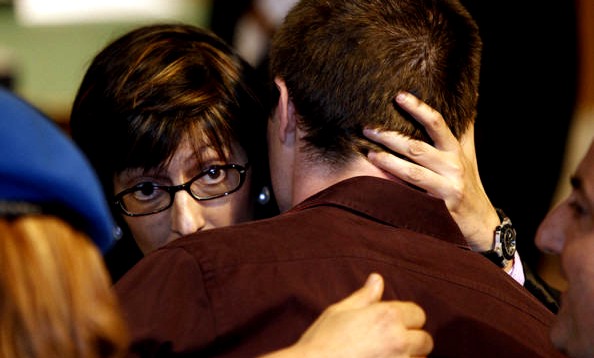
Sometimes it can be frightening to see how people’s self-interested choices turn around to bite them instead.
Had Knox and Sollecito simply told the truth to begin with, this case would have been only a nasty local story in Italy, with a bit of light coverage in Seattle and London. They would have had to accept some narrative that explained their involvement and their guilt, and they would have been sentenced accordingly.
They would then have served their time and gotten out. Eventually they would have gone on, perhaps, to live relatively normal lives.
After all, by the time they left prison virtually no one outside the families involved would remember, or much care, what they had done. Their criminal records would follow them forever, of course, but certainly there would have been no public repercussions for an obscure murder in Italy, years in the past.
People live with such pasts: they live their lives and create a future despite their pasts.
Instead, Knox and Sollecito have rendered themselves toxic for the rest of their lives. Everywhere they go, as long as they live, they will be recognized, whispered about, and pointed out by supporters, opponents, and even the relatively uniformed public.
Always.
Already, Sollecito’s Austrian side-trip was busted by someone who, predictably, recognized him. The intense paparazzi effect will eventually wear off, but years from now, whenever either of them does something simple, its effects will live on.
Apply for a library card ““ instant name recognition, walk through the airport - and someone will realize why that face is familiar. They’d better get used to it because some stranger will always recognize them. At their every life event, there will be a news alert, and someone potentially selling the story or a photo.
They and their families deliberately established an intensive PR effort for selfish reasons: in order to avoid the repercussions of a terrible act.
But this press creation is a terrible beast. Now that it is here it will need to be fed. Always. Get drunk in public - someone will have a cell phone handy; a marriage breaks up - the ex-spouse will tell all. (And, really, neither of them has the kind of money needed to live forever insulated from the vulgar public.)
For the rest of their lives, in everything they want to do, the whole did-they-or-didn’t-they narrative will be weighed in other people’s reaction: Would you hire either of them for anything? Would you rent them an apartment? Elect them to the school board?
All other things being equal, there will always be someone else available, someone equally good who has no awkward history. And everyone will know about that history; they worked hard to make it so.
And I’m not talking about the prejudice against ex-cons. That’s a real thing, and it will have its impact too. All convicted felons have real problems, after all, but few of them have achieved such notoriety, let alone embraced it. What I’m talking about is the impact of even old-news celebrity, of always now, and for the rest of their lives, being tabloid fodder.
Sure, there will always be people (Mad Pax?) drawn to the faux glitter of it all, but a life accompanied only by those wanting to share in your “fame” seems pretty ugly to me. What normal person wants the hassle of becoming involved with something like this?
Furthermore, they will never know when someone they think of as a friend might suddenly start thinking of a way to cash in. There might be a book in it, or at least a juicy article for a tabloid.
This isn’t meant as expressing any kind of sympathy for them at all, by the way. They have blood on their hands and horrors in their heads.
Eventually they may come to some kind of terms with their actions. Frankly, though, I hardly care, for it is not merely their crime that requires expiation. I have been sickened to see the unfolding ruthlessness and the sheer ugliness of their publicity campaign.
At its center their PR beast reveals an utter selfishness that is willing to appeal to the worst in their supporter through appeals to American xenophobia, to racism, and in smears against Meredith, Rudy, and Patrick, as well as the entire system of Italian justice.
The PR beast they created denigrates every other element in the case, while portraying the pair of them as young, innocent, and only guilty of a visible passion for each other and a naïve belief in the police.
This tactic required a media product for sale: the attractive young lovers. Their campaign has forced their names, and images and story in all our faces for years now. They and their families did this entirely voluntarily, and they have seemed to relish the attention it brought them.
They’ve been interviewed extensively, treated sympathetically by those who should know better, and altogether have had much more than their fifteen minutes of fame. But celebrity is a beast that turns on its own.
And, importantly, unlike other famous people ““ actors, politicians, authors and the like - there is no proper use for their fame. They have nothing real to share with us, only their story. It is, literally, all about them. And that is how it will remain.
They have become a narrative whose next chapter will always be told. The PR beast, for all its reach, will not be enough to keep them out of prison. But the cameras will be there the day they finally leave prison, in case we have forgotten their faces.
And there will be photos when they drive drunk. Or marry. Or divorce.
Their names are out there, waiting for the tagline, waiting for the joke. (“How bad is your new roommate? Well, at least she’s no Amanda Knox.”) There will be no end to it, ever. They will have no privacy, ever. Karma at work is a scary thing. They invited the beast into their lives, and now it will never leave them alone.
[Below: Said to be Amanda Knox leaving home hiding under a windcheater]

Tuesday, February 04, 2014
Defense Dirty Tricks: Did We Just See Yet Another One, An Attempt To Compromise Judge Nencini?
Posted by Jools
Judge Nencini offers corrections
This is my translation of a statement from Judge Necini carried by the Florence GoNews website.
“In relation to the press articles that reported my statements on the trial for the death of Meredith Kercher I intend to point out that there has been no interview organized or pre-arranged.
I ran into some journalists in the corridors of the courthouse who told me of the rumors and speculations that were being circulated on the duration of the deliberation session.
I then had a brief talk with them meant, in my intention, to clarify possible misunderstandings. In this I accept responsibility, reaffirming that I did not agree to disclose in any way the reasons for the sentence. In particular, I have not expressed any opinion on the strategy procedure followed by the defence of the accused.
In fact the only reference to that matter, reported in the article that appeared in Il Messaggero, is one in which I stated that the accused were defended in the process to a ‘very high standard.’
If my words have generated misunderstandings on this point and on the absolute legality of the choice of an accused to make spontaneous statements I regret it.
These explanations are dutybound for the respect I owe to the people who participated in the process with me and to the [Law] System of which I’m proud to be a part of; as well as for consistency in my professional history, with over thirty years of work carried out without spotlights and without interviews.”
Context for those corrections
This is in relation to the previous days articles claiming Judge Nencini supposedly gave an “inappropriate” interview to the press.
In very short order three or four lay members of the Superior Council of Magistrates (CSM) laid a complaint about non-appropriate conduct (under Art. 6 of the CSM rules) for a presiding appeal court judge to give press interviews commenting on the motivations reached by the judges on any sentence before its official publication.
Not surprisingly, the first people to complain were Bongiorno and Maori (grasping at straws, much?!!) and then to follow were these three or four lay members of the CSM, who happen to be also members of the centre-right political party “Forza Italia” (Berlusconi’s party).
As a result of the complaint made by these people, the Justice Minister, Annamaria Cancelleri, ordered an inquest on the allegations against Judge Nencini which could have led to his reprimand for disclosing details of the verdict reached to the press.
Personally, I think this all results from the desperation of Sollelcito’s defense and they have erncourgaed the others to instigate it. Making a meal out of nothing, in the hope that the whole appeal trial gets thrown out.
And let’s face it, it wouldn’t be difficult for Bongiorno to find some of Berlusconi’s people that are always looking for ways to attack members of the judiciary given Berlusconi’s hatred for the system. Just my opinion…
In any case, the allegations seem to be false, Judge Nencini actually didn’t say much, and the inquest will prove it, but in the meantime the press is concentrating on this rather than the hopeless work the defense produced. This maybe is the whole objective.
The later, longer interview
The interview by Fiorenza Sarzanini with Judge Nencini the following morning is claimed to be quite legal, because the decision of the court had been published the previous evening.
Andre Vogt kindly posted a very accurate translation on The Freelance Desk, and as it will scroll down soon and be hard to find, we can repost the full interview here.
Posted 1 February
Italy’s most influential newspaper, the Corriere Della Sera, this morning has published a fascinating long interview with Judge Alessandro Nencini about his reasons for convicting Amanda Knox. The interview was done by one of the newspaper’s most veteran crime and investigative reporters, Fiorenza Sarzanini. Click here to read the original.
HEADLINE: Amanda and Raffaele: The Judge Speaks
SUBHEAD: “I have children too; it was a huge burden.”
SUBHEAD2: “The defense had asked to separate the positions of the two accused, but Raffaele would not allow himself to be questioned.”
By Fiorenza Sarzanini
“I feel relieved because the moment of the decision is the most difficult. I have children too, and handing down convictions of 25 and 28 years for two young people is a very hard thing, emotionally.”
It is 10 am the day after the verdict and Justice Alessandro Nencini is in his office. The President of the Florentine Court of Appeals, which two days ago found Amanda Knox and Raffaele Sollecito guilty of the murder of Meredith Kercher, knows that the decision will “open up new debate, especially in the media”, but that is exactly why he agreed to explain how the verdict was reached.
You deliberated in chambers for 12 hours. Was the judicial panel divided?
“The case files took up half of the room. There are 30 expert reports. The lay judges, who aren’t court staff, had to read all the documentation to reach a joint decision, as is expected in the appeals court. You have to review all the documents, think about them, and reason. We did that using all the time that was necessary, and taking into account the fact that the victim was also a young girl.
And then the decision was unanimous?
“I spoke of a joint decision. I can say that in all these months and in particular during the last session of deliberations, we carefully considered the gravity of a verdict that involves young people and their entire families. This is a case that has consumed many lives.”
Yours was a narrow path, the Court of Cassation had urged you to remedy the Perugia appeal decision that had acquitted the two accused.
“Not so, we had maximum flexibility. The only restriction was that in the case of acquittal, we would have to have give reasons based on logic. There was no other binding restriction.”
Not even with regard to the decision handed down in Rudy Guede’s case?
“Effectively the specifics of the case was this: there was a person already convicted via fast-track, and definitively, for concourse in the same homicide. The Court of Cassation was asking us to consider who participated and their roles. We could have said that the two accused weren’t there, and then provided convincing reasoning, but we did not believe this to be the truth.”
Why didn’t you question Guede?
“For what purpose? He has never confessed and even if we had called him, he had the right to remain silent. We didn’t think it was necessary. Rather, we felt it was important to study the other aspects more in depth. In fact we requested an expert report and heard witnesses about which there were doubts. That is the role of the appeal judges. In four months, we’ve been able to arrive at a result.”
Sollecito’s lawyers had asked you to split the defence.
“We’ll explain the point more in the reasonings, where we will explain why we rejected that request. In any case, Sollecito did not want to be questioned during the trial.”And this influenced your choice to convict him?
“It is the defendant’s right, but certainly it removes a voice from the trial proceedings. He limited himself to making spontaneous declarations, saying only what he wanted to say, without being cross examined.”
Over the years, various motives have been speculated. What idea did you yourselves form?
“We convicted and we will explain it explicitly in our reasoning. For now, I can say that up until 20:15 of that evening, these young people all had different plans, then their commitments fell through and the occasion for this to happen was created. If Amanda had gone to work, we probably wouldn’t be here.”
Are you saying that the murder was just a coincidence?
“I’m saying this was something that unfolded between these young people. There may have been coincidences, and we’ve taken it into the reasoning. I’m aware this will be the most debatable part.”
Cassation demolished the acquittal. Will you as well?
“We are not going to mention it. We simply have to focus on the decision in the first instance (Massei) which we confirmed, on the facts.
And you don’t believe that there were errors?
“I didn’t say that. Some I believe there may have been and I’ll point them out.”
You convicted Amanda Knox, but didn’t issue any precautionary measures against her. Why?
“She is legally in the United States. At the moment of the offence she was in Italy to study and she went home after having been acquitted. She is an American citizen. The problem will arise when it is time to carry out the sentence. For now I don’t believe that such a measure wouuld have been necessary.”
So why then have you confiscated Raffaele Sollecito’s passport?
“It was the agreed minimum. In these cases such measures serve as prevention. We want to avoid that he makes himself impossible to find during the period of waiting for a definitive judgment.”
And you believe being forbidden to leave the country is enough?
“Yes, that seemed more than sufficient to us. If there are other developments later, we will consider them.”
Monday, February 03, 2014
Authors Of “Math On Trial” Bring The Explanations Of The Hard DNA Evidence Up To Date
Posted by Peter Quennell
The important new book in question Math On Trial is by mathematicians Leila Schneps and Coralie Colmez who is Leila’s daughter.
This article by Leila Schneps appeared in yesterday’s edition of The Independent and explains why the Nencini court has not ruled out any of the DNA evidence.
It’s not right to say there is “˜no evidence’ in the case against Amanda Knox. There’s plenty
The DNA alone is enough to raise questions
The verdict handed down yesterday at the new appeal trial for Amanda Knox and her former Italian boyfriend, Raffaele Sollecito, accused of the murder of British citizen Meredith Kercher in Italy in November 2007, may come as a surprise to those whose view of the case has been affected by an international media blitz based on the oft-repeated claim “There is no evidence”. Many believe that Rudy Guede, convicted in October 2008 for participating in the murder, acted alone.
There is, however, copious evidence to consider: the DNA alone is enough to raise questions. Leaving aside much of it, let’s focus for a moment on three key pieces of DNA evidence and present them from both sides, just as the jury may have heard them spoken of in court.First ““ the bra clasp.
The part of the victim’s bra containing the hooks had been ripped or slashed from the rest of her bra. Not immediately collected on that first day after the murder, it remained in the room in a sealed house for six weeks before being sent to the lab in December. There, it was tested and found to contain a large sample of Meredith’s DNA, together with a smaller but clearly visible contribution from Sollecito. The defence objections: firstly, between the two searches, objects in the crime room had been moved around, and indeed the bra clasp was found about a metre away from its original position.
Secondly, apart from “˜alleles’ - genetic traces - of Meredith and Sollecito on the clasp, there were a few unidentifiable extra ones. Putting these two facts together, the defence pointed out that Sollecito’s DNA on the bra clasp could have been a consequence of a careless police technician stepping on Sollecito’s DNA elsewhere in the flat and then entering the room and stepping on the bra clasp, even though no DNA of Sollecito was found anywhere else in the house except on a single cigarette butt in the ashtray.
Second ““ the mixed stain.
Although not visible to the naked eye, the chemical Luminol which flashes blue on contact with blood revealed a spot in the room of the flatmate whose window had been smashed and room rifled. Swabbing the spot produced a mixture of Amanda and Meredith’s DNA. This is a clear proof that the murderer entered that bedroom after the murder, as someone must have brought Meredith’s blood into the room, contradicting the defence theory that Rudy Guede broke into the house and then committed the murder.
The usual defence explanation for mixed DNA stains in the bathroom and corridor, namely that the house would have been coated in Amanda’s DNA given that she lived there, does not necessarily apply to a flatmate’s bedroom. It is much harder to leave traces of DNA than is commonly conceived, and hardly any of Amanda’s DNA was found in her own room - where she surely spent a lot more time than in her flatmate’s.
Lastly ““ the knife.
Days after the murder, a large kitchen knife was seized in Raffaele’s flat, where Meredith had never set foot. Police geneticist, Patrizia Stefanoni, swabbed spots on the blade of the knife and on the handle in the knife’s first DNA Test. One spot in particular attracted her attention: a visible scratch on the flat of the blade. The swab taken from this scratch yielded a positive ID for Meredith Kercher.
By the third trial, when a new attempt was made to collect DNA from the knife (which had been swabbed again during the appeal trial, though no tests were then conducted) there was no match to Meredith ““ a result welcomed by Knox’s defence team, though it did not in fact impact on the findings of the first trial.
Stefanoni’s test ““ she only conducted the first - came under strong fire in the courtroom. Two independent expert witnesses called in for the appeal against Knox and Sollecito’s original 2009 conviction stated that she had not worked in conformity with standard international protocol. Indeed, standard protocol for DNA testing involves three steps: first determining how much DNA is in a sample, secondly amplification, which reproduces the sample millions of times, and thirdly electrophoresis which produces the familiar DNA graphs showing peaks in the location of an individual’s alleles. Under cross-examination, Stefanoni explained that quantification had given a result of “too low” as the machine she used that day was not the most sensitive one in the lab.
Knowing that samples undetectable by the machine can still be sufficient to yield positive results, she chose to continue with testing. At the second stage of testing, amplification, a sample will normally be split into two or more pieces in order to run independent tests. But knowing that the sample was small, Stefanoni feared that cutting it in two would yield no result at all, and chose to amplify the entire sample in one unrepeatable test. The end result was a perfect match to Meredith Kercher.
Knox’s supporters have claimed since the beginning that the accusations levied against her are based on the Italian justice system’s hatred of a pretty, American girl who likes parties and having sex. And whilst both parties protest their innocence , Thursday’s decision shows that there is real evidence against her and Sollecito, that cannot be ignored.


